#Place de St. André des Arts
Text
ALEXANDRA STRÉLISKI
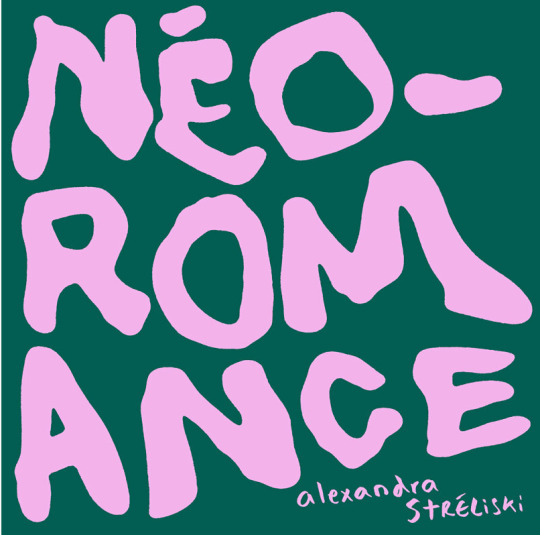
"UMBRA"
Hoy, XXIM Records/Sony Masterworks se complace en anunciar el lanzamiento de otro nuevo sencillo, 'Umbra', así como la versión ampliada de Néo-Romance, el disco aclamado por la crítica de la pianista francocanadiense y compositora ALEXANDRA STRÉLISKI.
Mira el vídeo AQUÍ
Consigue la versión ampliada del álbum AQUÍ
La pieza inédita viene acompañada de un videoclip rodado por Nick Helderman en La Marbrerie de Montreuil, Francia, con Julia Kotarba, Natalia Kotarba y Maxime Navert, miembros de la banda de gira de STRÉLISKI.
"Umbra" fue la última pieza que compuso para el proyecto y se terminó cuando ya se había grabado la mayor parte de Néo-Romance. "Umbra" hace referencia a la parte más oscura de la sombra, pero esta pieza se creó para intentar poner algo de luz en ella", dice STRÉLISKI. Convertida en el cierre habitual de sus conciertos, la pieza es ahora una de las favoritas de los fans, cosechando una calurosa acogida allá donde ha tocado.
"Es ahora una de mis piezas favoritas para tocar en directo", añade STRÉLISKI."Empezó siendo el final de mi espectáculo, con piano solo, y se convirtió en una celebración colectiva, basada en la improvisación. Me encanta interpretarla junto a mis maravillosas instrumentistas Julia y Natalia Kotarba, y con mi compañero de siempre Maxime Navert al sintetizador".
Un álbum centrado en la importancia del Romanticismo en el mundo moderno, y en lo que la relación de los románticos con la naturaleza puede enseñarnos en tiempos tan difíciles, Néo-Romance se ha convertido en un éxito comercial y de crítica. El disco alcanzó el nº 1 en la lista de álbumes de Québec -por delante de Taylor Swift- y ha sido nominado para el Premio Polaris de la Música 2023. STRÉLISKI estambién la artista femenina más nominada de este año en L'ADISQ - una ceremonia que recompensa la excelencia en la industria musical quebequense - con seis nominaciones en total.
Empezando con tres actuaciones en Múnich, Carouge y Zúrich, STRÉLISKI continuará su gira Néo-Romance con 30 nuevas fechas por Canadá, Estados Unidos y Europa durante el resto de 2023 y hasta 2024. A continuación, todas las fechas de la gira:
Ya se puede escuchar la versión ampliada de Néo-Romance aquí:
“NÉO-ROMANCE ON TOUR” 2023/2024:
2023
NOVIEMBRE
19/11 - MÚNICH (DE) - Milla
20/11 - CAROUGE (CH) - Le Chat Noir
21/11 - ZURICH (CH) - Kaufleuten
2024
ENERO
11/01 – QUÉBEC (CA) – Grand Théâtre de Québec
13/01 - TORONTO (CA) - Trinity-St. Paul's United Church and Centre for Faith, Justice and the Arts
17/01 - MONTRÉAL (CA) - Salle Wilfrid Pelletier de la Place des Arts
18/01 - MONTRÉAL (CA) - Salle Wilfrid Pelletier de la Place des Arts
FEBRERO
23/02 - BERLÍN (DE) - Colosseum
25/02 - HAMBURGO (DE) - Resonanzraum (Acoustic show)
26/02 – PARIS (FR) – Église Saint-Eustache
MARZO
05/03 - LONDRES (UK) - The Elgar Room Brasserie at the Royal Albert Hall
07/03 - EINDHOVEN (NL) - Muziekgebouw Eindhoven
08/03 - ROTTERDAM (NL) - LantarenVenster
27/03 - SHERBROOKE (CA) - Salle Maurice O’Bready
28/03 - SHERBROOKE (CA) - Salle Maurice O’Bready
30/03 - BROSSARD (CA) - Théâtre Manuvie
31/03 - BROSSARD (CA) - Théâtre Manuvie
ABRIL
01/04 - BROSSARD (CA) - Théâtre Manuvie
05/04 - L'ASSOMPTION (CA) - Théatre Hector-Charland
06/04 - L'ASSOMPTION (CA) - Théatre Hector-Charland
13/04 - SHAWINIGAN (CA) - Centre des Arts de Shawinigan
14/04 - SHAWINIGAN (CA) - Centre des Arts de Shawinigan
18/04 - SAINTE-THÉRÈSE (CA) - Théatre Lionel-Groulx
19/04 - SAINTE-THÉRÈSE (CA) - Théatre Lionel-Groulx
20/04 - TERREBONNE (CA) - Théatre du Vieux-Terrebonne
21/04 - TERREBONNE (CA) - Théatre du Vieux-Terrebonne
26/04 - LAVAL (CA) - Salle André-Mathieu
27/04 - LAVAL (CA) - Salle André-Mathieu
MAYO
02/05 - VANCOUVER (CA) - St. James Community Square
07/05 – SEATTLE (USA) – Fremont Abbey Arts Center
08/05 – SAN FRANCISCO (USA) – The Chapel
11/05 – CHICAGO (USA) - Constellation
12/05 – NEW YORK (USA) – Le Poisson Rouge
24/05 - SALABERRY-DE-VALLEYFIELD (CA) - Valspec - Salle Albert-Dumouchel
25/05 - SALABERRY-DE-VALLEYFIELD (CA) - Valspec - Salle Albert-Dumouchel
27/05 - GATINEAU (CA) - Salle Odyssée
28/05 - GATINEAU (CA) - Salle Odyssée
30/05 - AMOS (CA) - Théâtre des Eskers
JUNIO
12/06 - SAINT-JEAN-SUR-RICHELIEU (CA) - Théâtre des Deux Rives
13/06 - SAINT-JEAN-SUR-RICHELIEU (CA) - Théâtre des Deux Rives
SEPTIEMBRE
12/09 - SAINT-HYACINTHE (CA) - Centre des arts Juliette-Lassonde
13/09 - SAINT-HYACINTHE (CA) – Centre des arts Juliette-Lassonde
SIGUE A ALEXANDRA STRÉLISKI
Página web: alexandrastreliski.com
Facebook: @alexstreliski
Instagram: @alexstreliski
Twitter: @alexstreliski
TikTok: @alexstreliski
YouTube: @alexstreliski
0 notes
Text
Letreros, anuncios, avisos, rótulos ...
En la Place St. André des Arts (al lado de la Isla de la Cité), para ver esta maravilla hecha con cacerolas de cobre.

#Letreros anuncios avisos rótulos ...#¿Esta es la imagen y algunos datos (O no) la “Historia” la pones tú? ¡La tuya! ¿Lo harás...?
0 notes
Photo

I’m rereading a favorite book about Paris “Parisians”by Graham Robb. There’s a chapter called Marville. This begins by talking about this photographer but ends leaving you feeling very nostalgic about what changes have happened and will happen through time in Paris. This is the Place St. André des Arts where the chapter begins. The square was built around 1800 after the destruction of the church that stood here and was sold and demolished during the French Revolution. Some houses would be demolished in 1898 in favor of the construction of the rue Danton. More demolition was intended but the somewhat quirky architecture remains as testimony to the architecture before the restructuring of Paris in the 19th century. The second old photo goes back to Charles Marville (1813-1879), a successful, innovative French photographer of the 19th century. Today he is best known for his photos of the old quarters in central Paris. He was commissioned by the government of Napoleon III to document the city before the radical transformations by the prefect Haussmann. When I finished the chapter I had to run out myself to photograph the square. . . . #paris #marville #parisjetaime #parislife #parisart #parismonamour #parismaville #parislove #pariscity #villedeparis #iloveparis #parisfind (at Place Saint-André-des-Arts) https://www.instagram.com/p/CXs3sQttAis/?utm_medium=tumblr
#paris#marville#parisjetaime#parislife#parisart#parismonamour#parismaville#parislove#pariscity#villedeparis#iloveparis#parisfind
2 notes
·
View notes
Photo

Place St André des Arts, Paris, 1898 (photogravure) Photographer: Eugène Atget, Paris
16 notes
·
View notes
Text
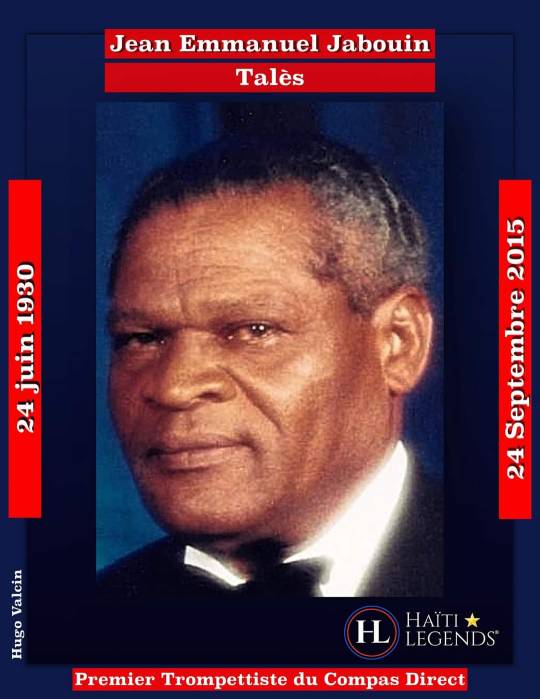
Haïti Legends ''Sa Nou Dwe Konnen''
Jean Emmanuel Jabouin '' Premier Trompettiste du Compas Direct''
Biographie
Louis Carl St-Jean.
De son vrai nom Jean Emmanuel Jabouin, Talès a vu le jour à la Croix-des Bouquets le 24 juin 1930. Il est le fils du Cayen Emmanuel Jabouin, ancien fonctionnaire de l’administration publique, et d’Indiana Victor, originaire de la Croix-des-Bouquets. À l’âge de 3 ans, Talès est frappé par la fièvre typhoïde, qui le laisse avec une légère paralysie des jambes. Peu après sa guérison (vers quatre ou cinq ans), il commence à manifester un intérêt pour la musique. Non sans rire, il raconte: « Je prenais plaisir à m’asseoir sur la « manoumba » lorsque les troubadours qui venaient se produire presque toutes les fins de semaine dans la cour de la maison de mes parents prenaient leur pause… Ces exécutants eux-mêmes prenaient plaisir à me regarder pincer les lames de cet instrument qui était plus grand que moi. »
En 1937, la mère de Talès déménage et s’installe avec son fils à la rue du Champ-de-Mars, presque au coin de la rue de l’Enterrement, au cœur du Morne-à-Tuf. La maison voisine est celle des époux Augustin Baron où se produit souvent le légendaire pianiste et musicien François Alexis Guignard (dit Père Guignard). En cours de semaine, il fabrique, avec des tiges de papaye, des saxophones qu’il joue, assure-t-il, avec la plus grande joie pour les voisins. En octobre 1941, Talès est admis à l’Ecole Centrale des Arts et Métiers où il apprend la musique et la trompette sous la direction du maestro Augustin Bruno.
En juillet 1947, Talès, frais émoulu de la Centrale, fait ses débuts avec l’Ensemble Anilus Cadet, dont le QG se trouve à la rue de l’Enterrement, en face de l’Hospice Saint François de Sales. Il joue alors à côté de Fritz Ferrier, d’Issalem « Sonson » Bastien et d’autres exécutants qu’Anilus recrutait au besoin. En septembre 1949, Talès occupe l’un des dix pupitres du Jazz des Caraïbes. C’est cet orchestre, monté par Issa El Saieh, qui, en février 1950, accompagne Daniel Santos, Estela « Tete » Martinez et d’autres stars latinoaméricaines de passage au « Simbie Night Club », au « Vodou Night Club » et dans d’autres boîtes de nuit port-au-princiennes. Nous tenons de lui cette confidence pour le moins étonnante: « C’est au sein de l’Orchestre des Caraïbes que je peux retracer mes meilleurs souvenirs sur la scène musicale… » Après la dislocation de ce dixtuor, Talès s’associe de nouveau au groupe d’Anilus Cadet, qui obtient le deuxième prix du carnaval de 1951 pour la méringue « Bèl carnaval ». (Le premier prix a été décerné à TI-TA-TO.)
À la même époque, Talès, Emmanuel Duroseau fils (piano), Montfort Jean-Baptiste (contrebasse), Louis Denis (batterie) et Marcel Jean (tambour) vont prêter leurs talents à Guy Durosier, qui, sur la recommandation d’Issa El Saieh, dirige l’Ensemble Tabou, le sextette de l’Hôtel Rivoli (Pétionville). Au cours de la même période, Talès accompagne dans les quatre coins du pays le troubadour Nicolas « Candio » Duverseau, grand chantre du magloirisme. Il joue aussi dans d’autres groupements d’occasion qui animent des pique-niques dominicaux et des soirées dansantes organisées le plus souvent par Stanislas Henry et Antoine Dextra à Carrefour Marin, commune de la Croix des Bouquets.
À la fin de 1951, Talès adhère à l’Orchestre Atomique Junior, monté par Nemours Jean-Baptiste après sa séparation de l’Orchestre Atomique. Au cours de l’année 1952, le groupe de Nemours est dissous. Immédiatement le bouillant maestro est appelé à diriger l’Orchestre Citadelle. Lorsqu’Hector Lominy se sépare de cet orchestre, Talès y est engagé pour seconder Jean Moïse. Véritable bûcheur, Nemours met sur pied parallèlement un petit groupement pour « faire la côte », selon l’expression de l’époque. Avec Dérico (chanteur), Webert Sicot (saxophone alto), Gérard Dupervil (trompette), son frère Montfort Jean-Baptiste ou parfois Augustin Fontaine (contrebasse), Hilaire ou parfois « Bibiche » (batterie) et d’autres musiciens, il sillonne par monts et par vaux les coins et recoins de la République, spécialement pour animer des fêtes champêtres.
En novembre 1953, Talès prend le chemin du Casino International et s’associe au Conjunto Panamerican dirigé par le trompettiste Emile D. Dugué. Il évolue alors aux côtés d’Ulysse Cabral (chanteur), Julien Paul (contrebasse), Charles Dessalines (saxophone alto), Gabriel Dasque (tambour), etc. Environ six mois plus tard, Talès s’écarte de ce groupe pour aller remplacer Kesnel Hall dans l’Orchestre Atomique, placé alors sous la baguette du pianiste Robert Camille. Il y passe moins de six mois et regagne l’Orchestre Citadelle pour succéder à Gesner Domingue.
Vers la fin de 1954, Nemours Jean-Baptiste, toujours maestro de l’Orchestre Citadelle, fonde le Conjunto International. Pour l’aider à égayer les clients des restaurants dansants de Jean Lumarque, dont l’un à Kenscoff, l’autre à Carrefour, il invite plusieurs musiciens, dont Talès à la trompette, à participer dans cette merveilleuse aventure : Dérico (chanteur), Mozart Duroseau (accordéon), Montfort Jean-Baptiste (contrebasse), Webert Sicot (saxophone alto), parfois Gary Labidou (saxophone alto) et Kreutzer Duroseau (tambour). Le 22 mars 1955, après les travaux d’agrandissement et d’aménagement du night club « Aux Calebasses » à Carrefour, « Le Conjunto » devient officiellement « Ensemble Aux Calebasses ». Il convient de rappeler que la date du 26 juillet 1955 a été symboliquement retenue comme celle de la fondation de la formation musicale de Nemours Jean-Baptiste, ancêtre, donc, du compas direct. Talès en sera le premier et unique trompettiste jusqu’à l’arrivée de Walter Tadal en 1956.
Lorsque, en septembre 1958, Nemours quitte « Aux Calebasses » pour aller se produire au « Palladium Night Club », de Sénatus Lafleur, il baptise son groupe de son nom: Super Ensemble Nemours Jean-Baptiste. « Alors, affirme Talès, prendra naissance le compas direct », genre musical dont il a été l’un des grands artisans, de concert avec Walter Tadal, Raymond Gaspard, Julien Paul, Louis Lahens, André Boston et de bien d’autres musiciens. Là-dessus, il sied d’entendre la voix de Talès pour mieux nous renseigner: « Quand on parle de compas direct, il faut avouer que Kreutzer Duroseau a été le véritable catalyseur de ce mouvement … Richard Duroseau représente l’âme même du compas direct… » (Entrevue avec Louis Carl Saint Jean, 22 octobre 2005.)
Le 5 juillet 1964, le Super Ensemble Nemours Jean-Baptiste entame une tournée aux Etats-Unis. Le 22 septembre, date du retour du groupe en Haïti, notre trompettiste, en parfait accord avec Nemours, fait ses adieux au compas direct. Il est remplacé par le brillant trompettiste jérémien Emilio Gay. Dès le début de l’année 1965, Talès entame sa carrière aux Etats-Unis. Sur la recommandation de l’excellent saxophoniste Charles Dessalines, il intègre « Los Ases del Sesenta » qui jouent à Broadway Cafe, Myrtle Avenue, Brooklyn. Il y restera jusqu’en mars – avril 1977. Moins d’un mois plus tard, il entre au Conjuto du chanteur cubain Monguito Guillan (dit « El Unico ») où évolue également le contrebassiste Fritz Grand-Pierre. Par la suite, Talès et Raymond Marcel jouent tantôt avec ''Enrique Rosa y La Sabrosa'' tantôt avec Johnny Dupre y su Orquesta Internacional. En 1980, Talès met fin à sa carrière musicale après avoir passé deux merveilleuses années au sein du groupe du chanteur dominicain Rafael Batista.
À part d’avoir été un talentueux trompettiste, Talès a également été un analyste fin et lucide de la question musicale haïtienne. S’il reconnaît en Nemours Jean-Baptiste « un maestro extraordinaire et un grand visionnaire », ses musiciens préférés ont toujours été : Antalcidas O. Murat, Guy Durosier, Murat Pierre, Michel Desgrottes, Raoul Guillaume, Richard Duroseau et Webert Sicot. D’ailleurs, comme Nemours Jean-Baptiste lui-même, Talès a toujours vu en Antalcidas Murat « un maître ». En outre, il n’a jamais passé par quatre chemins pour affirmer : « Je suis Haïtien avant d’être musicien […] C’était un honneur pour moi d’avoir joué dans le groupe de Nemours pendant près de quinze ans. Cependant, je dois avouer que le Jazz des Jeunes était, de loin, le plus grand ensemble musical du pays… C’est le Jazz des Jeunes qui jouait la vraie musique du pays... » (Entrevue avec LCSJ, 25 octobre 2005). Hubert François, Jean Moïse, Alphonse Simon, Raymond Sicot et André Déjean ont été ses idoles parmi nos trompettistes.
Si Talès était connu comme un très bon musicien, il jouissait aussi de la réputation d’un excellent père de famille. Tandis qu’il menait sa carrière de musicien, il a travaillé comme barbier pendant plus de deux décennies dans un salon de coiffure situé à Sterling Place, à Brooklyn. Il a ainsi assuré l’éducation de quatre merveilleux enfants que lui a donnés sa femme Denise Frédéric Jabouin qu’il a épousé en 1953: Reynald Jabouin, docteur en médecine (décédé à New York en janvier 2015); Patrick Jabouin, agent immobilier et docteur en Théologie; Fanya Jabouin Monnay, docteur en thérapie conjugale et familiale et Jean Emmanuel Jabouin, Jr., MBA en Marketing.
Après avoir parcouru sans naufrage notre espace immense, Talès se repose de ses œuvres merveilleuses depuis le 3 octobre 2015 au Forest Lawn Cemetery, à Fort Lauderdale, en Floride. Pour son émule Raymond Marcel: « Talès repésentait le modèle de l’ami fidèle... La sonorité suave de son jeu avait fait de lui l’un de nos meilleurs trompettistes. » De son côté, son ancien camarade Serge Simpson, deuxième accordéoniste et premier et unique vibraphoniste du Super Ensemble Nemours Jean-Baptiste, a salué en lui: « Un homme d’un comportement exemplaire. Le jeu de Talès à la trompette, poursuit Simpson, reflétait deux qualités rarement réunis chez une seule personne: la discipline et la bonne humeur. J'ai toujours gardé un grand respect pour ce musicien... » Puisse le nom de Jean Emmanuel Jabouin rester gravé à jamais dans la mémoire de tous ceux qui ont aimé la musique haïtienne en général, le compas direct en particulier. Ce n’est qu’un au revoir, Talès! Ce n’est qu’un au revoir!
Auteur:
Louis Carl Saint Jean
4 octobre 2015
#JeanEmmanuelJabouin
#Talès
#TompettisteCompasDirect
#Biographie
#LouisCarlStJean
#HugoValcin
2 notes
·
View notes
Text
ANDRE MASSON
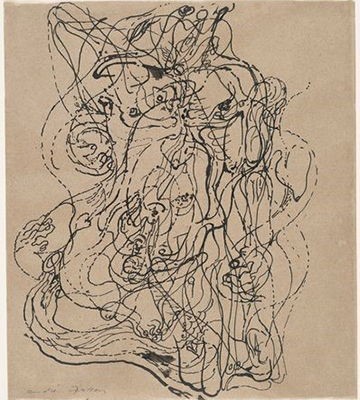
Andre Masson, Automatic Drawing, 1924
https://www.moma.org/collection/works/38201?artist_id=3821&page=1&sov_referrer=artist

Andre Masson, In the Tower of Sleep, 1938
https://art5308.files.wordpress.com/2016/11/magritte-book.pdf
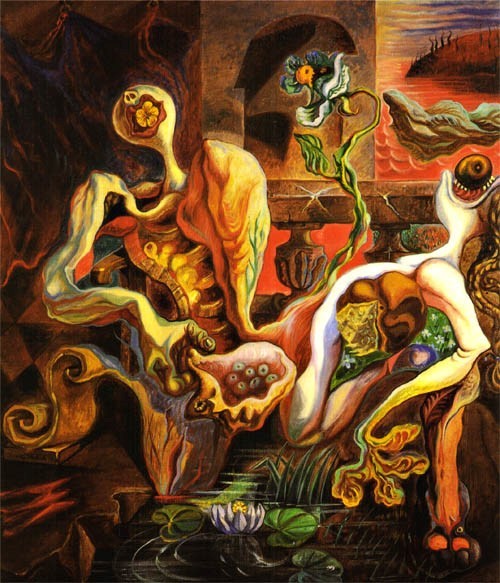
Andre Masson, The Metamorphosis of the Lovers, 1938
https://robdigitalimage.wordpress.com/2015/06/11/concepts/

Andre Masson, The Metamorphosis of the Lovers, 1938
https://utopiadystopiawwi.wordpress.com/surrealism/andre-masson/gradiva/masson-gradiva-1939/
Childhood
André-Aimé-René Masson was born on January 4, 1896, in the small town of Balagny (Oise), north of Paris. He was the eldest of three children in a family of modest means. Growing up in the country, he felt a former connection with nature and the world.
Masson's childhood encouraged unconventional thought. In particular, his mother was a French teacher who promoted unusual texts that would later become important to the Surrealists and were considered scandalous. While his father was more conservative in his beliefs, he did not interfere with Masson's artistic ambitions.
Early Training and Work
Through the efforts of his mother and the quality of his drawings, Masson was admitted to the Brussels Académie des Beaux-Arts at age eleven, which was much younger than usual. He studied under the Belgian painter and sculptor Constant Montald, whose method of mixing glue with water and pigment proved very influential for Masson's later technique. He also took a side job making embroidery designs, which meant his days were filled with study and work.
In his limited free time, Masson read insatiably. He was fascinated by the Quattrocento and the work of the Renaissance masters, along with fin-de-siècle artists like Paul Gauguin, Vincent van Gogh, and Paul Cézanne. He saw a continuum between the two, remarking when he first James Ensor's Christ in the Midst of the Storm, that "contemporary painting could be as extraordinary as the old masters!"
His interests continued to include the modern (he was shocked by Cubism when he first encountered the works of Picasso and Braque) and the traditional (he traveled to northern Italy in 1914 to study fresco painting). Masson also traveled to Switzerland and became fascinated with the philosophical writings of Frederich Nietzsche, which profoundly affected his personal life.
He returned to Paris in 1915 and joined the French army, enduring the violence, trauma and death of World War I trench warfare. He was discharged in 1917 after suffering a severe chest injury; he spent months recovering in military hospitals and spent time in a psychiatric facility. While the experience of being at war was not something Masson often explicitly spoke about, it was the root of the very violent imagery in his work and remained with him for his entire life. After his discharge, he met his wife, Odette Cabalé, and the two relocated to Paris.
Mature Period
In Paris, Masson began making pottery at a studio center for veterans with disabilities. He also took up work with the Journal Officiel. His work from these postwar years featured erotic, sometimes pornographic content that varied widely in style and technique. The founder of the Surrealist movement, André Breton, would later call this Masson's 'erotic period' and believed it to be key to understanding his entire oeuvre.
According to the writer Malcolm Haslam, Masson hosted regular gatherings in his Paris studio at 45 rue Blomet. Here, along with Antonin Artaud, Michel Leiris, Joan Miró, Georges Bataille, Jean Dubuffet, and Georges Malkine, the group experimented with altered states of consciousness, smoking hashish and opium added to wine and music, discussing writers central to the developing Surrealist movement: Nietzsche, Arthur Rimbaud, Comte de Lautréamont, and even the Marquis de Sade.
While vast and divergent in many ways, this group of works shared themes of deep uncertainty and humanity's coexistence with nothingness, ideas drawn from Nietzsche. This philosophy also featured themes of metamorphosis and argued for the changeable nature of organic existence, ideas that would become increasingly important to Masson's art.
In 1921, Masson met fellow artist Joan Miró through their mutual friend, Max Jacobs. Masson and Miró immediately began a friendship that would be influential to both of their careers. The group of artists often met at a studio on the rue Blomet that became a place of intellectual and artistic knowledge, discussion and exploration. Visitors included Ernest Hemingway, Gertrude Stein and the playwright Armand Salacrou, who were some of the first buyers of Masson's work.
In 1923, Masson was offered a contract by Daniel-Henry Kahnweiler, a notable art dealer. Although it was not (yet) highly paid, this opportunity allowed Masson to focus solely on his art career. The following years, which encompassed both the Dada movement and the birth of Surrealism, proved some of the most exciting and successful of Masson's career. His style was changeable, and he began to experiment with automatic methods of working, often incorporating motifs from ancient Greek and Roman mythology.
During the 1930s, Masson's work grew increasingly violent and disturbing. His 1930s series of slaughterhouse paintings, built on the art historical legacy of Chaim Soutine's Carcass of Beef (early 1920s) and Rembrandt's Slaughtered Ox (1655), but brought new brutality and sexual associations to the depictions of flesh and meat. It is speculated that this may have been due to his turbulent personal life at the time. Following a 1929 divorce, he met his second wife, Rose, broke with the Surrealist group and moved out of Paris to establish a more solitary life in St-Jean-de-Grasse. He then relocated to Spain, only returning to France in 1936 after witnessing atrocities in the years prior to the Spanish Civil War. Once back in France, he reconciled with Breton and the Surrealists.
In 1941, Masson and his family sought and secured political asylum in the United States, as did many of the Surrealists. Masson's time in America transformed and revitalized his work, introducing new variety in subject matter, style and motifs. He began to focus more on abstractions from nature, alongside his fascination with metamorphosis and cosmic unity. In 1943, Masson underwent his final split from Breton, however he continued to experiment with Surrealism as a style.
Late Period
At the end of World War II, Masson and his family were able to return to France in 1945. During a trip to the south of France, Masson became highly interested in southeastern Asian art and Taoism. His work became increasingly existential, conveying a sense of universal fusion through abstractions of natural landscapes. He remained based in Paris but traveled back and forth to a country house in Aix. In 1965, he was commissioned to paint the ceiling of the Odéon-Théâtre de France and although he was thrilled to complete the project; it proved to be taxing for the aging artist and it was his last major work. This large circular installation, featuring classical figures like Agamemnon and Shakespearean characters like Falstaff, was celebrated as a triumph. The actor Jean-Louis Barrault was said to have declared, "At last we have a sun over our heads." His later career included a series of landscape themes and non-objective paintings. Masson died at his home in Paris in 1987.
The Legacy of André Masson
Masson tackled many of the concepts central to Surrealism and established new ways of representing traditional themes trauma, angst, violence, sex, and death with modern imagery. The philosopher Jean-Paul Sartre credited him with "retracing a whole mythology of metamorphoses: (transforming) the domain of the mineral, the domain of the vegetable and the domain of the animal into the domain of the human."
Masson's work influenced numerous 20th-century artists, the most prolific being Jackson Pollock and Mark Rothko. Pollock's Action Painting in particular drew on Masson's experimental use of the automatic technique. Additionally, his use of block coloration and abstraction of form also strongly influenced other artists within the New York School. The practice of automatism has continued to resurface and remains an influence on contemporary art.
Masson's work was also of importance because of its eclectic and multifaceted nature. He experimented with different styles and techniques, so that although he is primarily associated with Surrealism, his work advanced perspectival elements found in Cubism and popularized the use of automatic methods of mark-making that channeled unconscious impulses into visual images. His long career included tremendous range, but featured deeply emotional transparency that allowed viewers to understand the emotional effects of war trauma.
3 notes
·
View notes
Photo

Place St. André des Arts, Paris 1948, Izis (1911 - 1900)
53 notes
·
View notes
Text
13 Coolest International Destinations You Can Visit Without a Passport
YOU DON'T NEED A STAMP TO EXPLORE THESE SURPRISING GETAWAYS.

When it involves traveling overseas, there's one essential thing you usually got to bring: a passport. But did you recognize that you simply can attend areas outside of the mainland us without a blue book? (And we're not talking Hawaii or Alaska!) From a tropical paradise in Central America to family-friendly islands across the Caribbean, there are a couple of secret places you'll visit without a passport—and we're here to inform you exactly the way to get there. So, read on, and determine where you'll skip the stamp on your next international vacation.
1 Montego Bay, Jamaica
Montego Bay is possibly the foremost popular tourist destination in Jamaica and a serious cruise liner port. Hit the "Hip Strip," formally referred to as Gloucester Avenue, for shops, art galleries, and colorful cafés. But, of course, you're in Jamaica, so do not forget the beach! Doctor's Cave Beach is that the hottest choice because of its turquoise water perfect for snorkeling. and every one these wonderful Jamaican attractions are often visited without a passport if you're traveling by water. If you're on a cruise that begins and ends within the states, all you would like maybe an occident Travel Initiative-approved document, sort of a certificate and government-issued ID, or an enhanced driver's license.
2 Cabo San Lucas, Mexico
Cabo San Lucas is found below the state of California, down on the southern tip of the Lower California peninsula in Mexico. This beautiful beach resort destination is understood as a favorite amongst the celebs for its proximity to Hollywood. you'll go there year-round and possibly see celebrities like George Clooney, Jennifer Aniston, or maybe Justin Bieber himself. Hit The Spa at Las Ventanas if you would like to urge a Jennifer Lopez-approved glow, and eat fresh at Flora Farms like Adam Levine. and fortunately, consistent with the Los Cabos Airport Immigration regulations, Americans don't need a passport to go to this beautiful destination. Instead, you'll use a certificate, voter registration card, citizenship card, or certificate of naturalization alongside a legitimate photo ID.
3 Puerto Limon, Costa Rica
You may think there is no way you're stepping into Costa Rica without a passport, seeing as it is a country in Central America—but re-evaluate. Many Miami- or San Diego-based cruises sail bent Puerto Limon, one among the most important cities on the coast of Costa Rica. Here, you'll explore the city's untouched nature by taking an open-air tram ride through the Veragua Rainforest or taking a pontoon boat through the Tortuguero Canal. And as a crop-heavy area, don't leave on faith out an area Costa Rican plantation, where you'll see how items like bananas, chocolates, or cacao beans are selected, harvested, and packed for export.
4 Belize City, Belize
You better believe you'll love Belize, even without a passport. This city in Belize (just like its Costa Rican cousin Puerto Limon) is accessible through cruises out of the states, from cities like New Orleans and Miami. And while Belize isn't known for its beaches, per se, here you'll explore the Belize coral reef, which hosts diverse, exotic marine life. But what you absolutely cannot afford to miss in Belize is that the Mayan ruins. the foremost popular is Altun Ha, located just 3o miles northwest of Belize City. For thousands of years, the Mayans occupied this space, and core structures were restored so that today, tours could take visitors to the present historic landmark.
5 Roatán, Honduras
Located off the coast of Honduras, Roatán is an island called in the Caribbean. But unlike other Caribbean destinations, this one offers paradise without the high tag. Around 30 miles long, this small island may be a popular retirement destination thanks to its exotic, yet laid-back tropical nature. And its best secret? it is a hot spot for skin diving. The island is surrounded by the Mesoamerican Reef, a subculture of coral reefs, mangroves, and magnificently unique marine life. While you will need a passport to urge there by plane, countries like Honduras are "waiving the need for cruise passengers unless those passengers start or end their voyage there." So as long as you're on a closed-loop cruise that starts and ends within the states, you're liberal to explore paradise sans passport.
6 Saipan, Northern Mariana Islands
The Northern Mariana Islands have the simplest of both worlds: Scenic oceans and mountainous landscapes. As a commonwealth of the U.S., the 14 islands that structure the Northern Mariana Islands are located within the northwestern Pacific on the brink of Guam, another unincorporated territory. Most of the population lives on Saipan, the most important island. you'll either visit one among its breathtaking beaches like Micro Beach or experience an off-road adventure to the rocky Forbidden Island. But the pièce de résistance is that the Banzai Cliff, a historic war II area on the northern tip of the island. As an area for both reflection and paying respects, the scenery off this cliff is breathtakingly beautiful. And a bit like Guam, per the U.S. Customs and Border Protection's Carrier Information Guide, U.S. citizens who travel directly between the states and one among the territories "without touching a far off port or place," aren't required to present a passport.
7 Hamilton, Bermuda
Nestled within the middle of Bermuda is Hamilton, the island's capital. the town is understood for its pastel-colored buildings that line the harbor and house beach-chic boutiques and native restaurants. Visit the town Hall and humanities Centre for a few fascinating 17th- and 18th-century European paintings or the Bermuda Underwater Exploration Institute if you are looking for marine exhibits and ocean artifacts. But if you would like to travel to the simplest a part of Bermuda, you will have to travel across the town to Horseshoe Bay Beach—one of the world's most Instagrammable beaches, with blush pink sand and crystalline water. to urge here without a passport, take a closed-loop Royal Caribbean cruise from Cape Liberty, New Jersey.
8 Tumon, Guam
As an unincorporated U.S. territory, Guam is probably the furthest American-based place you'll visit, nestled within the Philippine Sea near Australia and South Asia. Tumon is found on the northwest coast of the territory, referred to as the middle of Guam tourism. There you'll visit UnderWater World, one among the most important tunnel aquariums within the world. or maybe take a visit to Punta Dos Amantes, a clifftop destination with scenic ocean views. And while having a passport is suggested for anyone traveling to Guam, there are some loopholes for U.S. citizens where they'll be ready to get out of it. Videos say Americans can visit the world passport-free if traveling directly from the mainland, Alaska, or Hawaii, and that they have any proof of citizenship sort of a certificate or certificate of naturalization.
9St. John, U.S. Virgin Islands
Located within the Caribbean, St. John is that the smallest of the U.S. Virgin Islands, but it is the perfect destination for anyone who loves natural beauty. Nearly two-thirds of the island is haunted by Mary Islands park, which shelters forests filled with many colorful birds from cuckoos to warblers and hummingbirds. But when you are not getting your forest fill, visit the gorgeous Trunk Bay beach, which has sugar soft sand and a treasured underwater snorkeling trail. Like most U.S. territories, you do not need a passport to travel here, but the U.S. Virgin Islands tourist center recommends carrying a raised-seal certificate or government-issued photo ID as you would possibly get to "show evidence of citizenship."
10 Montreal, Canada
Contrary to popular belief, as long as you're traveling by land or sea—so as an example, in your car—you aren't required to point out a U.S. passport thanks to the occident Travel Initiative. Instead, you ought to carry along proof of your citizenship and a legitimate photo ID. But if that creates you nervous, there are closed-loop cruises that begin from various New England cities and sail to Montreal. This French-speaking Canadian city is as close as you'll get to Europe without a passport. Here, you'll enjoy French pastries like macarons or visit historic landmarks that rival those in Paris, just like the Notre-Dame Basilica of Montreal.
11 Nassau, Bahamas
The Bahamas is one of the foremost popular cruise destinations from the states, and like many who've gone known, you do not need a passport. because the capital of the Bahamas, Nassau is found off the shore of the mainland on its island. One feature that draws tourists is the pastel-colored Colonial buildings, just like the Government House which may be a bright shade of pink. But Nassau, of course, is not just about the buildings—it's about the beach retreats. Within the past few years, a mega-resorts opened in Nassau called Baha Mar. The 1,000-acre, $4.2 billion property is comprised of three hotels: the Grand Hyatt, SLS Baha Mar, and Rosewood Baha Mar. And when hunger strikes, breeze by The Cove at Atlantis for fresh seafood at Fish by chef José Andrés.
12 Vieques, Puerto Rico
Puerto Rico is perhaps the foremost well-known U.S. territory, so there is no got to stress over getting a passport before visiting. As long as you're directly traveling from the states or another territory, it isn't necessary. So while you're there, you ought to visit Vieques, a little Caribbean Island off the territory's eastern coast. This area offers secluded beaches, beautiful blue-green waters, and therefore the best part? Wild horses that just roam the countryside. But if that does not roll in the hay for you, visit Mosquito Bay, a bioluminescent bay that gives other-worldly views that can't be missed.
13 San Juan, Puerto Rico
Don't recoil from the mainland of Puerto Rico, however. San Juan, the capital and largest city, sits beautifully on its northern coast. If you are looking for a wild tropical trip, visit the Isla Verde resort strip, filled with buzzing bars, nightclubs, and casinos. need a more calm, historic vacation? Take a visit to Old San Juan, the center of colorful Spanish colonial buildings and historic landmarks like La Fortaleza, where the governor resides, or El Morro, a Spanish fort that dates back to the 1500s.
2 notes
·
View notes
Text
site preview

hi all! we’re back with our second preview. we’ll have another couple coming to you soon as well. below the cut you’ll find some general information about paris as well as arrondissement descriptions that’ll be part of our site encyclopedia. it’ll be presented a little differently on the site, but the information below will remain the same.
GENERAL OVERVIEW
as the capital of france, paris boasts a population and counting of over two million residents. the city of paris is often described as two-fold. there is paris “proper” which designates the historical city and its 20 arrondissesments, and then the paris metropolitan area that includes the suburbs surrounding paris.
paris-proper does not include skyscrapers, the notable exception is the tour montparnasse and it’s the only skyscraper built in the middle of the city. the building height in paris-proper is limited to the height of 19th century buildings, roughly 10 floors, and most apartment buildings, built by haussmann during the napoleonic era, are six stories tall and tend to be either reserved as luxury homes in the 1st and 6th arrondissement, or are divided in miserly studio apartments.
these building restrictions are to preserve the historical cahcet of the city but also has been the reason the city cannot accommodate the growing population. the housing crisis in paris has been going on for over a century and has not improved since. it is the second most expensive city to live in in the world and anyone living on middle-class wages would either be doing so within the city walls by sharing an apartment or living in substandard conditions. it is not uncommon for students, struggling artists, or performers to occupy shared rooms and small apartments through illegal subletting to cut living costs.
outside paris-proper lies the outer metropolitan parisian suburbs. these range from the chic saint-gratien and sanois, where one can enjoy the tranquility of a nice house and space galore, to the lower-socioeconomic areas like argenteuil, saint-denis and cour-neuve. poverty piles up in the french version of subsidized housing units known as les cités, these are tower complexes where families share the life of an impoverished community leading to any and all excesses such pressures can induce. the outer suburbs are linked to paris-proper by train system, the RER.
THE ARRONDISSEMENT SYSTEM
the twenty arrondissements refer to the twenty subdivisions of paris-proper. they are arranged in the form of a clockwise spiral (often likened to a snail shell), starting from the middle of the city, with the first on the right bank (north bank) of the seine. the smaller the number of the arrondissement, the older and more historical the area is.
first - also known as the ‘premier’ arrondissement. the heart of the city carries some parts of the right bank such as les halles, which has been there since the middle ages. in addition, a large part of this arrondissement is occupied by the louvre and tuileries garden. the central arrondissement is one of the smaller and least populated of all paris. however, what the area lacks in full-time population it certainly makes up for in sheer tourist numbers.
second - known as ‘bourse’ the second arrondissement of the city is the financial one and as such, is home to the parisian stock exchange as well as a myriad of banks and financial institutions. bourse is also the smallest of all arrondissements. bourse is also home to the textile district, sentier and has the highest concentration of covered passages that the city has to offer. these 19th-century built commercial lanes are often covered in beautiful art nouveau façades.
third - the old jewish quarter or ‘temple’ as it is also known is a lively and trendy district, with many faces. you will find lots of high-end art galleries close to beaubourg (which is in the fourth arrondissement). while its winding old streets are full of vintage shops and beautiful hôtel particuliers. temple is also home to the first chinese community in the city as well as museums such as the picasso museum, carnavalet museum, and musée des arts et métiers.
fourth - home to the lively part of le marais; an area filled with bars, clubs, and restaurants which remain open into the early hours of the morning. with a plethora of beautiful and historic architecture throughout this arrondissement it also has top tourist attractions like notre dame, and centre georges pompidou. the fourth arrondissement has a growing lgbtqi+ population living in the area with many spaces for the community.
fifth - a district known worldwide for its history and culture, with sights like the panthéon, the roman arenas (les arènes de lutèce) and the cluny museum. it is also known as the latin quarter of the city, the fifth arrondissement of paris is well-known for its vintage cinema screenings and as a hub of student nightlife. this area is home to some of paris’ most prestigious universities (sorbonne), colleges and high schools.
sixth - known for its famous quartier saint-germain-des-prés, a meeting place for students, artists, and intellectuals during the twenties. visitors come here looking for this long since disappeared atmosphere and are ready to pay ridiculous prices in places like cafe de flore or cafe les deux magots. six is home to luxembourg gardens, saint sulpice church, and nice winding streets. it is also a great district for foodies in paris, as well as luxury boutiques and art galleries, with plenty of tourists ready to empty their wallets here.
seventh - home to the upper-class since the seventeenth century when it became the new residence of french highest nobility. this bourgeois district has the eiffel tower, invalides, and lagerfeld; as well as big avenues with beautiful hôtels particuliers transformed into embassies. the only lively part which deserves a mention are the streets around rue de bac, at quartier sèvres-babylone, full of nice haute-couture and prêt-à-porter shops.
eighth - this is the district of fashion and luxury symbolized by the famous “golden triangle” formed by rue montaigne, rue george v and avenue des champs-élysées. the eighth arrondissement is ultra luxe and undeniably elegant. it is one of paris’ main business quartiers, the current executive branch of french government is based here as well as the élysée palace, where the french president resides.
ninth - from the red-light district of pigalle to opéra garnier, this is a trendy and historic area with its old cafes, offices and haussmannian architecture where you can still can find a true neighborhood life and culture. the streets around st. lazare were parisian central for impressionists. today, the early 19th-century architecture and lovely courtyards have been discreetly preserved. but, watch your safety on rue saint denis.
tenth - one of the trendiest districts in paris, linked to canal saint-martin waterway and iron footbridges. this is a district of bobos (bohemian-bourgeois parisians), with agreeable cafes and vintage shops. it is also the district of two major train stations: gare du nord and gare de l’est. it boasts an always busy and popular atmosphere with a lot of bars at rue de faubourg saint-denis.
eleventh - this arrondissement is one of the most densely populated and urban. with neighborhoods like bastille and oberkampf filled with expats, “hipsters” and young parisians. nightlife is booming, but in a street alley kind of way (don’t expect red carpets). you want to fit in with the urban crowd, explore little wine bars and tiny bistrots on avenue ledru rollin and rue de charonne.
twelfth - the park district of paris. home of parc floral, bois de vincennes, and parc de bercy. it is one of the more residential areas and has more affordable housing than a lot of other arrondissements. a very sleepy district, this quartier went through a major transformation in recent years, and now has modern shops and arena in bercy. you’ll also see opéra de la bastille – the second largest opera house in paris is also a much more modern architecture compared to opera garnier.
thirteenth - a kind of no man’s land with a very popular character and a strong chinese population. this district of paris has some cool things to see and do like the arty butte-aux-cailles neighborhood, some quintessential paris bistros or its incredible street art. the mural program in thirteen has invited the most renowned street artists in the world to give some color to this district of paris.
fourteenth - a predominantly residential quartier that carries a sleepy charm. home to many artists around the world and “the breton” (northwesterners of france) community, this area may be residential but also has many vibrant cafes on boulevard du montparnasse and the rue daguerre. it is also home to parc montsouris, one of the most beautiful parks in paris, as well as the catacombs.
fifteenth - another residential area where locals aren’t too keen on its 1970s high-rises, hence they’ve coined the term moche grenelle (ugly grenelle) to describe parts of the area. located on the left bank of the seine, this arrondissement is home to the likes of the pont bir-hakeim, as well as several parks, notably that of andré-citroën. definitely a family district, very quiet, with no special character, and a long way from everything.
sixteenth - locals call it le seizième, due to the affluent population in the french pop culture. it is the parisian version of new york’s upper east side or london’s kensington. here, you’ll see the most prestigious residential areas in paris and the most luxurious hotels, like the peninsula hotel, and hotel raphael. sixteen also welcomes the french open tennis grand slam every spring. don’t be surprised if you run into an expat family in which the parents have been relocated to work in france.
seventeenth - this district is formed by three very different neighborhoods: merchant quartier de ternes, bourgeois quartier monceau, and arty quartier de batignolles. the 17th is known for batignolles district that was originally outside of paris until napoleon iii included it as part of the city in 1860. a group of artists such as édouard manet based in this area to make a name for themselves by painting scenes of cafes. much like the 15th arrondissement, this area is slightly less touristy than many of the others.
eighteenth - this is the most paradoxical of arrondissements in paris. it is home to montmartre, the quintessential neighborhood in paris, but there are also popular zones long forgotten by everybody like little india, africa, and the infamous goutte d’or neighborhood. with strong bohemian roots it was a gathering place for composers, writers and artists to live in a commune and draw inspiration from the area. many have made their mark here, including: salvador dalí, amedeo modigliani,claude monet, piet mondrian, pablo picasso and vincent van gogh.
nineteenth - a former industrial area developed along canal de l’ourcq. today it is a very popular district with a strong mix of immigrants and a very parisian soul at the same time. it is home to two wonderful parks, parc buttes-chaumont, and parc de la villette. a primarily residential district also known for its world renowned music schools, conservatoire de paris and the philharmonie de paris, both part of the cité de la musique.
twentieth - a few years ago, this was the cheapest district in paris, that’s why so many young parisian couples with lower budgets came here to live. today it is one of the trendiest and most authentic districts of paris and all this without tourists! best known for being home to père lachaise cemetery, there are not many other tourist sites here. however, it has cool cafes, bars, some street art and parc de belleville offers some of the best views of the city of light.
5 notes
·
View notes
Photo

Jun 29 1918 La fontaine Saint-Michel, place St-André-des-Arts et boulevard Saint-Michel, Paris (VIe arr.), France, A 14 395 S 29 juin 1918 Source: Albert-Kahn Museum / Department of Hauts-de-Seine https://t.co/r14uG5aBdK http://twitter.com/ThisDayInWWI/status/1145021611109523457
8 notes
·
View notes
Text
18 de Agosto: Bordeaux
Nos gusta Bordeaux? La tierra es redonda? El CGPJ sigue sin renovarse? Hay realidades indiscutibles. Hoy hemos dedicado el día a repasar los lugares más relevantes de la ciudad, empezando con el Marché des Capucins.
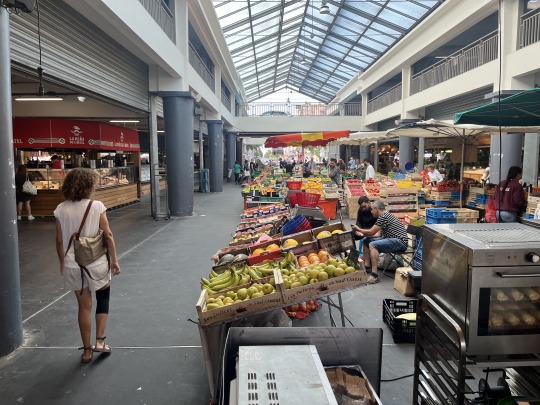
Siguiendo con la Iglesia de la Sainte Croix (cerrada, como siempre).
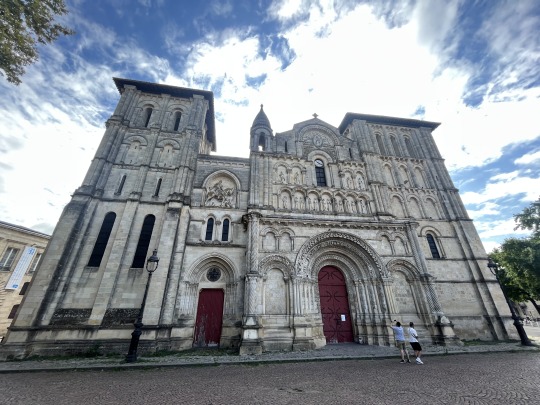
Es cita inevitable la Basílica de St-Michel, con su correspondiente campanario.
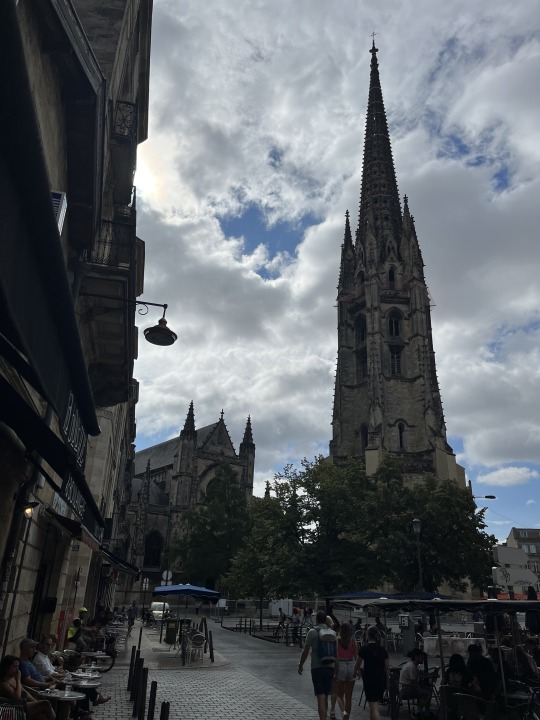
Siguiendo la ruta en paralelo al río, hemos pasado por la Porte Cailhau.

Como no se puede dejar pasar una iglesia, había que figurar frente a St. Pierre antes de llegar a la Place de la Bourse frente al río Garonne. Como ayer sacamos fotos de la Aduana y la Bolsa, hoy hacemos la foto girada hacia la Quai de la Douane.
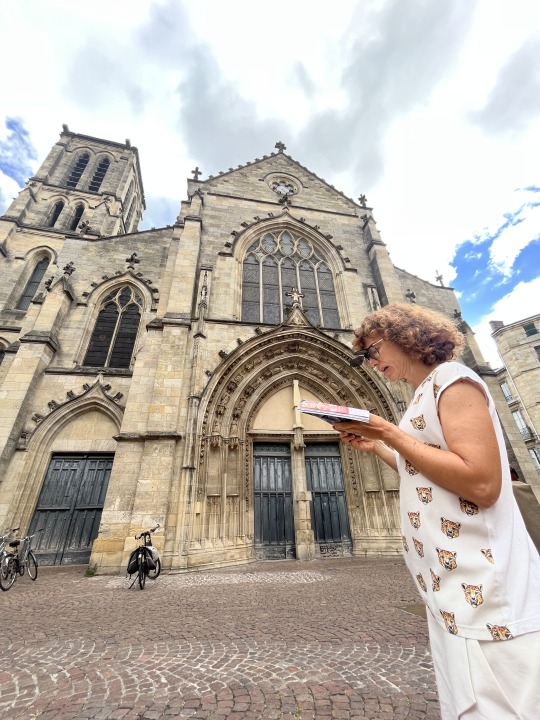
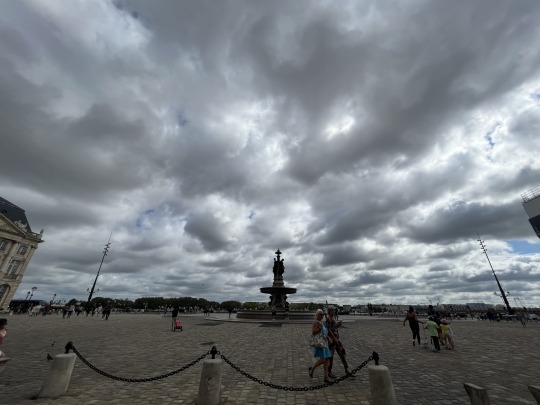
Y por fin llegamos a uno de los puntos álgidos del día: nuestro paso por Aux marveilleux de Fred para comernos una cramique aux raisins!! La felicidad!
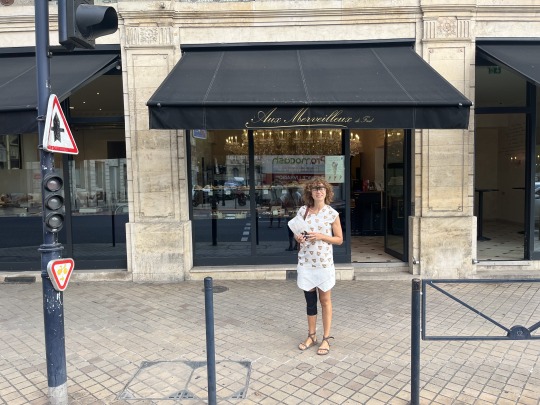
Hemos seguido junto al río en dirección al barrio de Chartrons (en mi opinión, el mejor barrio de la ciudad), pasando por la Bolsa y el Templo - para llegar a la iglesia de Saint-Louis de Chartrons. No hay foto que capture la calidad de vida que se respira en Chartrons.

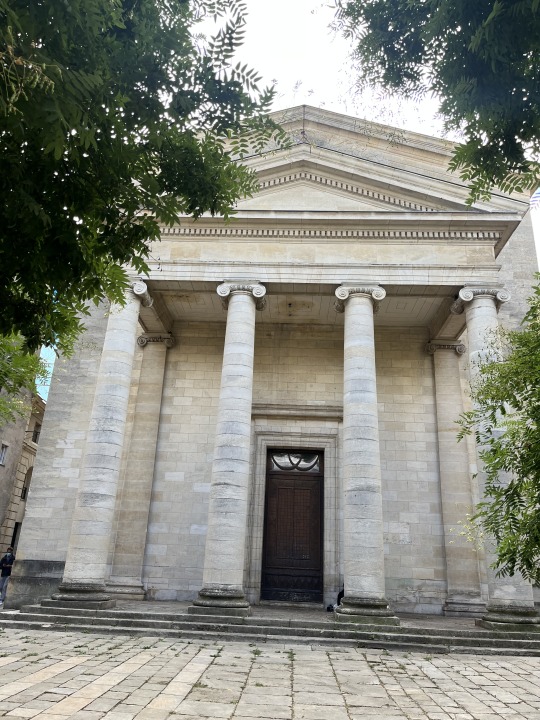

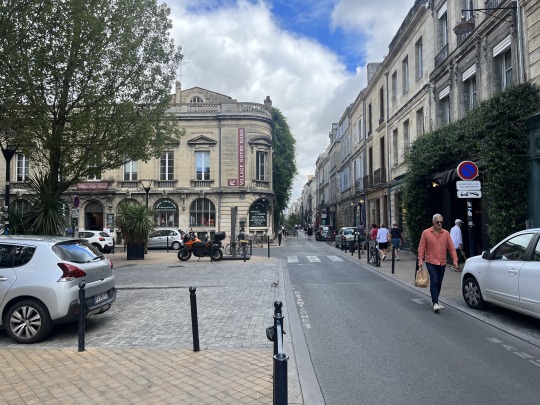
Y si consideramos que el Jardin Public forma parte de este barrio, ya es como un chuletón al punto: imbatible.
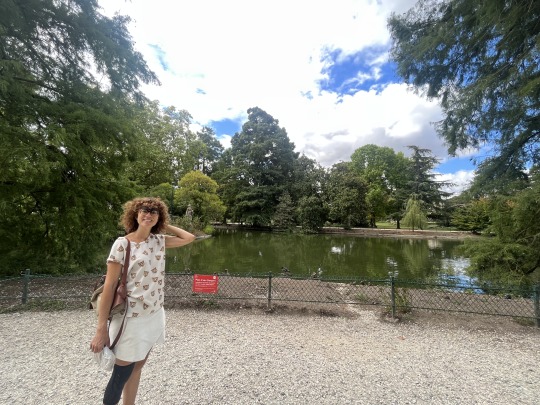
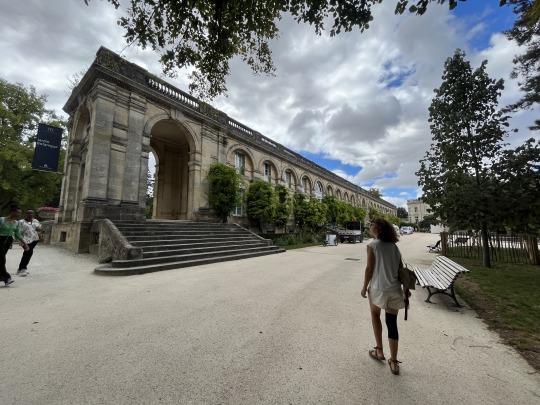
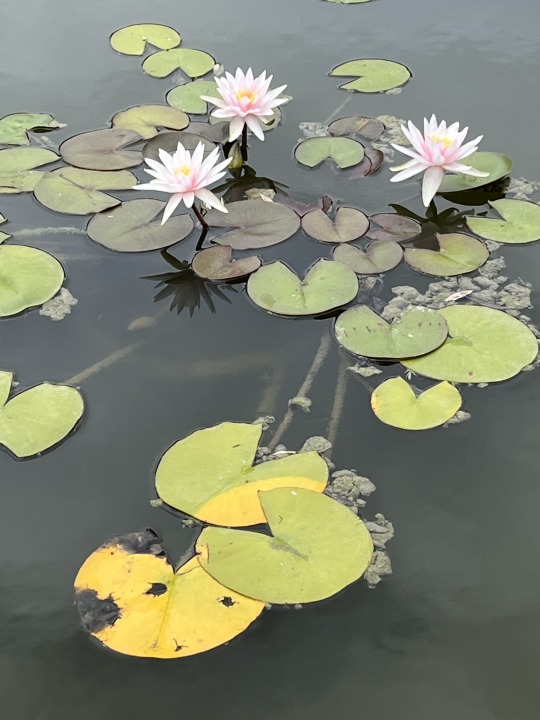
Por tener, tiene hasta los restos de un anfiteatro romano, el Palais Gallien.

Y, de remate, hemos pasado por la basílica (y cementerio paleocristiano) de Saint-Seurin, que ya es otro barrio. Lo que más nos ha llamado la atención es su cripta, con los túmulos de varios santos.


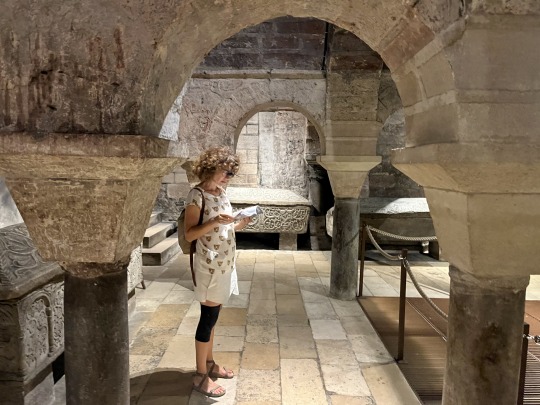
Tras el regreso a casa para apretarnos un buen couscous de merguez, hemos ido a visitar el Museo de Bellas Artes. Nos han dejado pasar gratis porque la cajera era de padres portugueses. Aparte de esa frivolidad, hemos disfrutado de los comentarios en audio, disponibles gratuitamente en su web, a la que he accedido a través de la red wifi gratuita del ayuntamiento. En Francia saben qué es el estado del bienestar y para qué sirven los impuestos.
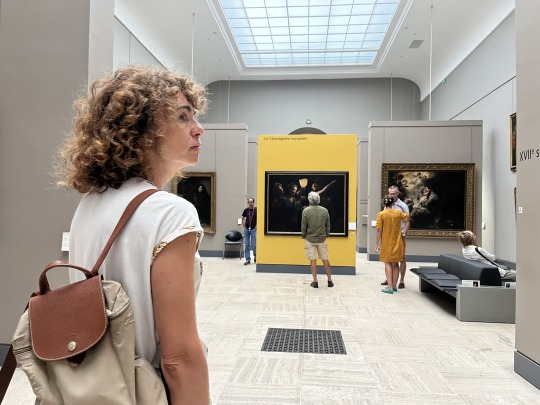
Mientras visitábamos el museo ha caído un pequeño chaparrón que, a pesar del susto, no ha impedido disfrutar de la visita y del paseo posterior por la ciudad.

Después de eso hemos vuelto a casa a tomarnos un café y acabarnos el bollo de la mañana y coger fuerzas para el último arreón. Empezando por la catedral de San Andrés.
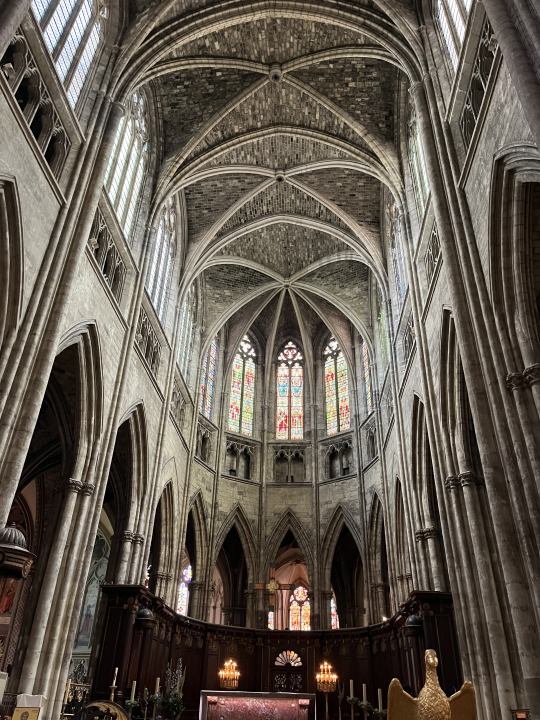
Bajando por Victor Hugo se ve la Grosse Cloche:
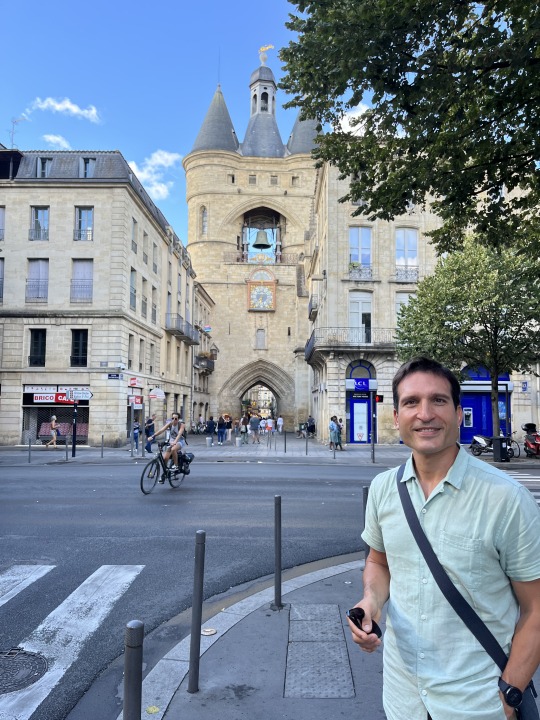
Y bastante más tarde ya hemos pasado (tras la FNAC) por la plaza de la Ópera.
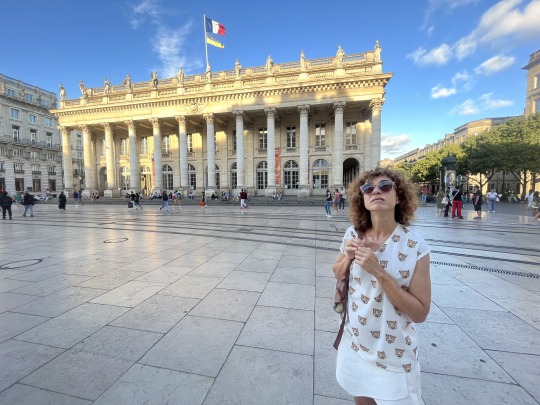

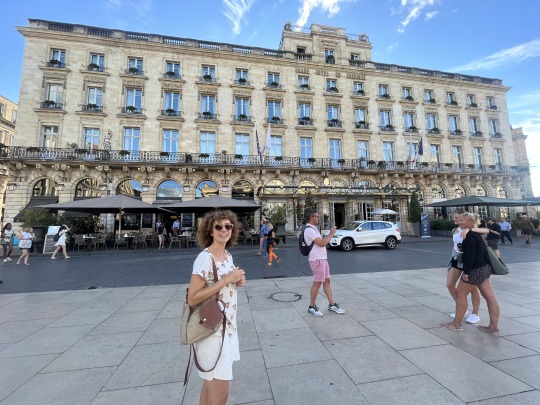
Y hemos presentado nuestros respetos como siempre a don Francisco de Goya (insigne exiliado víctima de la ola reaccionaria que siguió al regreso del infausto Fernando VII) a las puertas de Nôtre-Dame, la iglesia donde se celebraron sus responsos cuando falleció.

En Francia se vive bien. Incluso una sardinada tiene una categoría... qué sé yo... une outre chose.
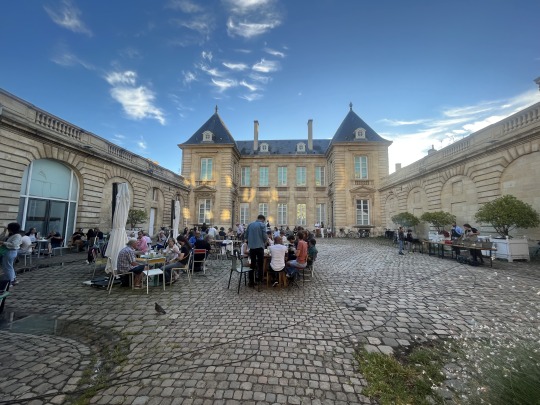
Y ya está! Se acabó lo que se daba. Comienza la recta final de las vacaciones. Mañana salimos hacia Anglet y nos bañaremos en la playa por última vez antes de tomar rumbo hacia Salamanca el domingo.
Buenas noches!
1 note
·
View note
Text
LES POLISSONS DE LA CHANSON : HOMMAGE À GEORGES BRASSENS
Ce spectacle-événement tournant autour de l’œuvre de Georges Brassens verra le jour dès la semaine prochaine, la tournée débutant à la Salle Pauline-Julien de Sainte-Geneviève le mercredi 20 avril. Pour fêter l’œuvre de ce monument de la chanson française, La maison fauve a réuni de grands artistes d’ici au sein d’un spectacle collectif mis en scène par nulle autre qu’Alice Ronfard, dans une conception d’éclairage signée Julie Basse. Ainsi, Valérie Blais, Luc De Larochellière, Michel Rivard, Saratoga et Ingrid St-Pierre voyageront dans l’immense corpus mélodique de l’auteur-compositeur-interprète pour en faire résonner son timbre chaleureux, son verbe libre, poétique et irrévérencieux, sous la direction musicale d’Yves Desrosiers.

Récemment, Michel Rivard s’entretenait avec le Téléjournal de Radio-Canada : « Si on aime la langue, si on aime le plaisir des mots, si on aime la subtilité, la nuisance, la poésie dans sa forme la plus pure, on ne peut pas ne pas aimer Brassens ». Lors de cette même rencontre, Alice Ronfard qui signe la mise en scène du spectacle, parlait de l’importance de l’autre chez Brassens : « Il parle beaucoup d’amitié, il parle beaucoup des copains… de cette chose qu’on a perdu depuis deux ans, c’est-à-dire, d’être ensemble… pour moi, c’est ça le lègue (de Brassens »). Le duo Saratoga parle quant à lui soulignait l’audace de cet artiste qui encore aujourd’hui résonne : « Il a touché à tout ce qui dérangeait, tout ce qui était un peu en marge, mais ça a terriblement bien vieilli ». La plume de Sylvain Cormier pour Le devoir ne pourrait mieux conclure : « Valérie Blais a vu Brassens sur scène, et Michel Rivard lui a serré la main. Un seul degré de séparation. Pour nombre de spectateurs, ce sera presque y toucher. Pour ceux qui découvriront Brassens — oui, ça se peut ! —, l’occasion est à chérir ». C’est à ne pas manquer! Tout ce beau monde à un plaisir manifeste à partager la scène, clin d’oeil et sourires en coin. La camaraderie de Luc, Valérie, Ingrid, Michel, Michel-Olivier et Chantal saura convaincre. Ce sont les plus sympathiques polissons de la chanson!
ÉQUIPE ARTISTIQUE :Mise en scène : Alice Ronfard
Interprètes : Valérie Blais, Luc De Larochellière, Michel Rivard, Saratoga et Ingrid St-Pierre
Musiciens : Yves Desrosiers (direction musicale et arrangements), François Lalonde et Mario Légaré
Conception des éclairages : Julie Basse
DATES ET LIEUX DES REPRÉSENTATIONS :
20 avril : Sainte-Geneviève – Salle Pauline-Julien
21 avril : Joliette – Centre culturel Desjardins
23 avril : Rimouski – Salle Desjardins-Telus
26 avril : Québec – Grand Théâtre de Québec
27 avril : Saguenay – Théâtre Banque Nationale
28 avril : Drummondville – Maison des arts Desjardins Drummondville
29 avril : Terrebonne – Théâtre du Vieux-Terrebonne
30 avril : Longueuil – Théâtre de la Ville
4 mai : Saint-Eustache – Le Zénith Promutuel Assurance
5 mai : Sherbrooke – Centre culturel de l’Université de Sherbrooke
6 mai : L’Assomption – Théâtre Hector-Charland8 mai : Saint-Jean-sur-Richelieu – Théâtre des Deux-Rives
11 mai : Brossard – L’Étoile
12 mai : Victoriaville – Le Carré 150
13 mai : Saint-Jérôme – Théâtre Gilles-Vigneault
14 mai : Sainte-Agathe-des-Monts – Théâtre Le Patriote
19 mai : Laval – Salle André-Mathieu
20 mai : Saint-Hyacinthe – Centre des arts Juliette-Lassonde
21 mai : Gatineau – Salle Odyssée
18 juin : Francos de Montréal – Théâtre Maisonneuve de la Place des arts
0 notes
Text
Becoming Machine: Surrealist Automatism and Some Contemporary Instances
Involuntary Drawing
DAVID LOMAS
Examining the idea of being ‘machine-like’ and its impact on the practice of automatic writing, this article charts a history of automatism from the late nineteenth century to the present day, exploring the intersections between physiology, psychology, poetry and art.
Philippe Parreno’s The Writer 2007 (fig.1) is a video, played on a screen the size of a painted miniature, of the famous eighteenth-century Jaquet-Droz automaton recorded in the act of writing with a goose quill pen. Zooming in on the automaton’s hand and face, Parreno contrives to produce a sense of uncertainty as to the human or robotic nature of the doll. It is an example of a contemporary fascination with cyborgs and with the increasingly blurred dividing line between machine and organism. In a manner worthy of surrealist artist René Magritte, Parreno plays on the viewer’s sense of astonishment. As the camera rolls, the android deliberates before slowly writing: ‘What do you believe, your eyes or my words?’ The ‘Écrivain’ is one of the most celebrated automata that enjoyed a huge vogue in Enlightenment Europe. In a lavish two-volume book, Le Monde des automates (1928), Edouard Gélis and Alfred Chapuis define the android as ‘an automaton with a human face’.1 A chapter of this book, which supplied the illustrations for an article in the surrealist journal Minotaure, is devoted to drawing and writing automata.2 The oldest example Gélis and Chapuis cite was fabricated by the German inventor Friedrich von Knauss whom, they state, laboured at the problem of ‘automatic writing’ for twenty years before presenting his first apparatus in 1753.3

Fig.1
Philippe Parreno
The Writer 2007
Photographic still from DVD
3:58 minutes
Courtesy the artist and Haunch of Venison, London © Philippe Parreno
The graphic trace
From the mid-nineteenth century onwards, recording instruments became vital tools in the production of scientific knowledge in a range of disciplines that were of direct relevance to surrealism. Such mechanical apparatuses, synonymous with the values of precision and objectivity, quickly became the benchmark of an experimental method. The inexorable rise of the graphic method has been intensively studied by historians of science and visual culture, but surrealism has not yet been considered as partaking of this transformation in the field of visual representation. In what follows, recording instruments are shown to have helped to underwrite surrealism’s scientific aspects and bolster its credentials as an experimental avant-garde.
The graphic method inaugurated a novel paradigm of visual representation, one geared towards capturing dynamic phenomena in their essence. It was the product of a radically new scientific conception of the physical universe in terms of dynamic forces, a world view that is doubtless at some level a naturalisation of the energies, both destructive and creative, unleashed by industrial capitalism.5The proliferation of mechanical inscription devices in the life sciences coincided with the displacement of anatomy, as a static principle of localisation, by physiology, which analysed and studied forces and functions. Étienne-Jules Marey, known today as an inventor of chronophotography, was one of the main exponents of the graphic method in France, and he personally devised a number of instruments whose aid, he wrote, made it possible to ‘penetrate the intimate functions of organs where life seems to translate itself by an incessant mobility’.6 As an apparatus for visualisation, the graphic method carries implications for how to construe figures of the visible and invisible. It was not simply a technology for making visible something that lay beneath the human perceptual threshold (like a microscope), but rather a technology for producing a visual analogue – a translation – of forces and phenomena that do not themselves belong to a visual order of things.7
At its simplest, a frog’s leg muscle is hooked directly to a pointed stylus that rests on a drum whose surface is blackened with particles of soot from a candle flame (fig.2). An electrical stimulus causes the muscle to contract, deflecting the stylus and thus producing on the revolving drum a typical white on black curvilinear trace. Fatigue of the muscle produces an increased duration and diminished amplitude of successive contractions, as shown in the figure at the bottom. A more sophisticated device pictured by Marey consisted of a flexible diaphragm, a sort of primitive transducer, connected by a hollow rubber tube to a stylus, which inscribed onto a continuous strip of paper. At the heart of the graphic method is the production of a visible trace.8 A stylus roving back and forth on a rotating cylinder or a moving band of paper translates forces into a universal script that Marey regarded as ‘the language of the phenomena themselves’ and which he proclaimed is superior to the written word.9 In an era where quantitative data gradually became the common currency of scientific discourse, Marey considered written language, ‘born before science and not being made for it’, as inadequate to express ‘exact measures and well-defined relations’.10 The incorporation of a time axis owing to the continuous regular movement of the drum lends a distinctive property to the graphic trace. The historian Robert Brain remarks that ‘the graphic representation is not an object or field like that of linear perspective, but a spatial product of a temporal process, whose order is serial or syntagmatic’.11 Units of time are marked off at the bottom of the myographic trace as regular blips on a horizontal axis; additionally, the passage of time is registered in the palimpsest-like layering of successive traces.12

Fig.2
Simple myograph (top) and trace of repeated muscular contractions (bottom)
From Etienne-Jules Marey, La Méthode graphique dans les sciences expérimentales et principalement en physiologie et en médecine, Paris 1875, p.194
From its initial applications in physiology, the graphic method soon made inroads into areas such as medicine and psychology, eager to prove their scientific legitimacy. The familiar chart of a patient’s temperature, pulse, and respiration had become standard fare in hospital wards by the mid-nineteenth century.13 Marey went so far as to predict that the visual tableau comprised of such ‘medical curves’ would replace altogether the written record. The growth of medical specialties saw doctors attempting to justify their status and claims to authoritative knowledge by adopting the tools-in-trade of an experimental science. The Salpêtrière Hospital in Paris, under neurologist Jean-Martin Charcot, was at the forefront of these developments, and graphic traces are liberally interspersed among the better-known photographs, engravings, and fine art reproductions of Charcot’s book Iconographie de la Salpêtrière (1878). Employed first for the investigation of muscular and nervous disorders, the myograph was subsequently applied by Charcot to the study of hysteria. By enabling the hysterical attack to be objectively recorded in the form of a linear visual narrative, the graphic trace performed an invaluable service in conferring a semblance of reality upon a condition that was widely dismissed as mere playacting or simulation (fig.3).

Fig.3
Epileptic phase of an hysterical attack
From Paul Richer, Études cliniques sur l’hystéro-épilepsie ou grande hystérie, Paris 1885, p.40.
Nearer in time to the surrealists, the hysteria problem was revived with particular urgency in the guise of shellshock, and there again physicians placed their faith in the graphic method as a means of reliably excluding simulation where clinical observation alone was of no avail. Evidence of the surrealist André Breton’s first-hand acquaintance with such devices is not hard to find. Soon after his arrival at the neuro-psychiatric centre at St Dizier in August 1916 he writes excitedly to Théodore Fraenkel, a fellow medical student, saying that all his time is devoted to examining patients. He details his technique for interrogating his charges and in the same breath adds ‘and I manipulate the sphygmometric oscillometer’.14 The instrument to which Breton refers gives a measure of the peripheral pulses and would have been used by him to detect an exaggerated vascular response to cold that was held to be a diagnostic feature of reflex nervous disorders. There is a reasonable likelihood that Breton also came in contact with the use of a myograph for the same purpose, either at St Dizier or the following year when he was attached as a trainee to neurologist Joseph Babinski’s unit at the Pitié Hospital in Paris. Breton possessed a copy, with a personal dedication from the authors, of Babinski and Jules Froment’s Hystérie-pithiatisme et troubles nerveux d’ordre réflexe en neurologie de guerre (1917), a textbook profusely illustrated with myographic traces.
As a newly formed discipline, psychology was also quick to integrate the paraphernalia of experimental physiology.15 Alfred Binet, one of the pioneers of psychology in France, employed the graphic trace as an instrument more sensitive in his opinion than automatic writing for revealing a dissociation of the personality in cases of hysteria. ‘In following our study of the methods that enable us to reveal this hidden personality’, Binet writes, ‘we are now to have recourse to the so-called graphic method, the employment of which, at first restricted to the work-rooms of physiology, seems, at the present time, destined to find its way into the current practice of medicine’.16 The definition of psychology as experimental is seen to be closely tied with the use of a measuring instrument. Binet’s goal appears to be an almost paradoxical exclusion of the subject, with its nigh infinite capacity for dissimulation, from the scientific investigation of that subject’s own subjectivity. Coinciding with the introduction of quantitative forms of measurement, introspection rapidly fell into disrepute as a method of inquiry. Robert Brain’s observation that in the field of psychology ‘the graphic method served both as a research tool and a source of analogies for investigating mental activities’ is certainly to be borne in mind with regard to surrealism.17
Alongside mainstream science, recording devices also made incursions into psychical research. The use of such apparatuses to restrict the latitude for fraud contributed to the general air of scientific enquiry. The historian Richard Noakes has shown that the intractable problems of researching mediums, their notoriously capricious and untrustworthy nature, led some experimenters to suggest that sensitive instruments alone could replace the human subject as a means of accessing the spirit world.18 In the 1870s, William Crookes, a respected chemist and a pioneer in the application of measuring instruments to spiritualist research, devised an apparatus for recording emanations from the body of the medium Daniel Dunglas Home, as a result of which he claimed to have discovered a mysterious new form of energy, which he termed ‘Psychic Force’ (fig.4).19 A Marey drum was used to make physiological recordings of the medium Eusapia Palladino, who had been often exposed for cheating in the past, during a highly publicised series of séances conducted under controlled experimental conditions at the laboratories of the Institut général de psychologie in Paris.20

Fig.4
Apparatus for recording the emanation of psychic force from a medium.
From William Crookes, Researches in the Phenomena of Spiritualism, London 1874.
Modest recording instruments
It would appear that surrealism was not indifferent to the lure of the graphic method. The particular aspect to foreground here is the promise of objectivity. The graphic method offered the prospect of bypassing altogether the human observer who was increasingly liable to be viewed as a source of error in scientific experiment. With precision and objectivity the yardsticks of science by the latter part of the nineteenth century, the historian Peter Galison remarks that ‘the machine as a neutral and transparent operator … would serve as instrument of registration without intervention and as an ideal for the moral discipline of the scientists themselves’.21 Addressing the graphic trace in these terms, Marey strikingly adumbrates the language of surrealism in remarking that ‘one endeavoured to write automatically certain phenomena’.22 The surrealists spoke of their art and literary productions as objective documents and advocated an objective stance that sidelines the authorial subject who was meant to be as near as possible a passive onlooker at the birth of the work. Or, in Breton’s words, a modest recording device: ‘we, who have made no effort whatsoever to filter, who in our works have made ourselves into simple receptacles of so many echoes, modest recording instruments not mesmerised by the drawings we are making.’23 Closely allied with this imperative to become akin to a machine is a metaphorics of the trace and tracing: ‘here again it is not a matter of drawing, but simply of tracing’, Breton insisted in the 1924 ‘Manifesto of Surrealism’.24
The accent on objectivity is consonant with surrealism’s avant-gardist ethos of experiment, stemming ultimately from science. In fact, Breton contended that by the time the manifesto had been published, five years of uninterrupted experimental activity already lay behind it.25 Around the time of the manifesto, the surrealists set about creating a research centre of sorts, the short-lived Bureau of Surrealist Research, testifying to the earnestness of their experimental impulse. However, it was no ordinary laboratory that opened to the public at 15 Rue de Grenelle, Paris, in October 1924. The surrealist playwright and poet Antonin Artaud recalls that a mannequin hung from the ceiling and, reputedly, copies of the crime fiction volume Fantômas and Sigmund Freud’s The Interpretations of Dreams framed with spoons were enthroned on a makeshift altarpiece. The second issue of the house journal La Révolution surréaliste, the cover of which was modeled on the popular science magazine La Nature, carried an announcement of its purpose:
The Bureau of Surrealist Research is applying itself to collecting by all appropriate means communications concerning the diverse forms taken by the mind’s unconscious activity. No specific field has been defined for this project and surrealism plans to assemble as much experimental data as possible, without knowing yet what the end result might be.26
Asserting a parallel with science, as Breton was fond of doing, was a way of implying that surrealism was dedicated to finding practical solutions to vital problems of human existence, and of distancing it as far as possible from a posture of aesthetic detachment. The statement above identifies the unconscious as the privileged object of surrealist research. Automatism, from this point of view, could be understood as a research method, a set of investigative procedures that organise and govern practice but do not determine outcomes. The openness of scientific inquiry is something that may have been especially attractive to surrealism; the final clause above insists upon their refusal to define goals – a programme – which would have run the risks of a reductive instrumentalism or empty utopianism. At the same time, however, bearing in mind the extreme animosity towards positivism that Breton notoriously gives vent to in the 1924 manifesto, the dangers for surrealism of too close a proximity to science should not be overlooked. Perhaps for this reason, Artaud, in a report on the bureau carried in the third issue of the journal, argues warily for the necessity of a certain surrealist mysticism. A survey of the terms ‘research’ and ‘experiment’ in the period would reveal that much the same vocabulary was utilised in the marginal, pseudo-scientific world of spiritualism and parapsychology as by mainstream science, and it is notable that surrealist experimentation happily straddles these seemingly contradictory currents. The hypnotic trance sessions, one of the main experimental activities engaged in by the nascent surrealist group, are illustrative of this cross-over between science and the occult. 543 pages of notes and drawings obsessively documenting the sessions, which took place nightly between September and October 1922, were preserved by Breton and included among a list of artworks, books and other objects housed in the bureau.
While Salvador Dalí did not partake of the ‘birth pangs’ of surrealism, as Breton ruefully observed, his overheated imagination provides a vivid if fanciful evocation of this first phase of surrealist experiment. In an essay written in 1932, Dalí conjures up an improbable scenario of hypnotic subjects wired to recording devices like the unfortunate frog in Marey’s illustration, though in this case it is the trace of poetic inspiration that is expectantly awaited:
All night long a few surrealists would gather round the big table used for experiments, their eyes protected and masked by thin though opaque mechanical slats on which the blinding curve of the convulsive graphs would appear intermittently in fleeting luminous signals, a delicate nickel apparatus like an astrolabe being fixed to their necks and fitted with animal membranes to record by interpenetration the apparition of each fresh poetic streak, their bodies being bound to their chairs by an ingenious system of straps, so that they could only move a hand in a certain way and the sinuous line was allowed to inscribe the appropriate white cylinders. Meanwhile their friends, holding their breath and biting their lower lips in concentrated attention, would lean over the recording apparatus and with dilated pupils await the expected but unknown movement, sentence, or image.27
Dalí clearly took to heart Breton’s exhortation to his fellow surrealists that they should make themselves into ‘modest recording instruments’. Inspired by extant photographs that afford a rare glimpse of the legendary bureau, Dalí conjures up a fantastical laboratory with pliant subjects hooked to a plethora of arcane recording devices.
Beyond a serviceable metaphor employed by Breton, what evidence is there for the graphic method as having any bearing on the actual practice of automatic drawing? While scattered instances of direct citation of graphic traces can be demonstrated, what is more significant is that this novel regime of visuality, beginning as a style of scientific imaging and becoming by the time of surrealism a widely circulated and understood visual idiom, was a necessary historical antecedent in order that the automatist line might be imbued with meaning as the authentic trace of unconscious instinctual forces and energies (in its absence, they would have been literally unreadable in these terms). With the precedent of the graphic trace available to them, it was possible for surrealist artists to imagine how they might square the circle by integrating temporal duration within a static visual medium.
‘Could it be that Marcel Duchamp reaches the critical point of ideas faster than anyone else?’, wondered Breton. It is a question that can profitably be asked in examining the impact on avant-garde artists of an avowedly scientific visual idiom. Duchamp, and his artistic collaborator Francis Picabia, around 1912 to 1913 rejected traditional painterly techniques, along with extreme subjectivism that had reached a zenith in the neo-symbolist circles both artists had been involved with up until that point, and turned instead to technical drawing and scientific illustrations as alternative, non-artistic sources of inspiration. Duchamp’s 3 Standard Stoppages 1913–14 (fig.5) is evidence of his search for what art historian Linda Dalrymple Henderson calls ‘the beauty of indifference, the counterpart to his painting of precision’.28 For this work, one-metre lengths of thread were allowed to fall from a height of one metre, and the random configurations formed as they came to rest on the ground were fixed and recorded. Displaying the resultant shapes as curved white lines on a long horizontal black strip of canvas would have rung bells with viewers familiar with the then standard repertoire of scientific imaging practices. The typical format of the graphic trace served as a convenient shorthand by means of which Duchamp encoded the desired values of precise measurement and objectivity. Not for the first (or last) time did Duchamp appeal to forms of visual competency that had begun to creep into the common culture, as art historian Molly Nesbitt’s pioneering study relating his use of technical drawing to reforms in the French school curriculum shows.29 The creation of wooden templates or stencils based on the resultant curves is also significant: these were utilised to transfer the curves to other works, notably Network of Stoppages 1914 (Museum of Modern Art, New York) and the capillary tubes in the Large Glass 1915–23 (Tate T02011), but in addition they provide a measure of the area beneath the curve which, as every student of basic calculus knows, is equal to the integral of the curve.

Marcel Duchamp
3 stoppages étalon (3 Standard Stoppages) 1913–14, replica 1964
Tate
© Succession Marcel Duchamp/ADAGP, Paris and DACS, London 2018
Of the surrealist artists, links between art and science run deepest in the work of Max Ernst, who attended lecture courses on psychology while he was a student at university in Bonn.30 Scientific illustrations and tables are frequent source materials for Ernst’s collage, among which are examples of graphic traces, most notably the illustrations to the book Les Malheurs des immortels (1922), a collection of collages and automatic poems produced collaboratively with the surrealist poet Paul Éluard. Between the Two Poles of Politeness is one of at least two collages in the book to utilise a graphic trace, which functions as a ground for the image and a springboard for the artist’s imagination. The typical white-on-black format is exploited by Ernst to evoke a night sky against which the solid white line of the trace stands out starkly. He embellishes the horizontal x-axis marked on the graph by a dotted line with a distant polar landscape that appears to echo the peaks and troughs of the graphic trace. At the left-hand edge of the image, the lines of the graph are extended so they appear to converge towards a vanishing point; the net effect of these hand-drawn additions is to produce incongruities of scale as well as an ambiguous play between the flat space of the diagram and an illusory perspectival space. Accentuating the horizon serves to foreground the idea of a horizon of vision, beyond which normally one cannot see, and thus implies the existence of an invisible realm to which surrealism affords access.
From 1919 through to the manifesto of 1924 – a period of intense experiment with automatic writing and other means for penetrating the unconscious, including hypnosis – Breton’s poetry is replete with imagery of electric currents and magnetic fields, to which the title of Ernst’s collage may allude. Ernst’s deployment of a graphic trace in the context of this book can be seen as mounting a polemic in favour of collage as an equivalent to automatic writing. Breton, who the following year in his poem ‘Sunflower’ penned the exquisitely apposite phrase, ‘the white curve on a black ground that we call thought’, would have understood that the graphic trace in Ernst’s collage offers itself to be read as an indexical equivalent to thought, in no ways inferior in this respect to the automatic text on the facing page.31Ernst’s painting North Pole 1922 is contemporaneous with the collage and closely related to it.32 A distinctive fine wavy pattern across the upper half of the canvas, the result of dragging a fine comb or something similar across the black oil paint so as to expose the white support, is highly suggestive of a seismographic or magnetic trace. There is a direct connection between this work and Ernst’s use of frottage and other automatic procedures in the 1920s. Between 1927 and 1928 Yves Tanguy produced a number of quite distinctive automatist paintings in which undulating lines are scratched into a black ground. Of even greater significance than such isolated examples of the direct citation of graphic traces, however, is to recognise that the novel regime of visuality it inaugurated made possible a mindset that saw the automatist line as an authentic trace of unconscious instinctual forces and energies. In its absence, they would have been literally unreadable in these terms. The surrealists were not alone in choosing to regard the unconscious as a repository of imperceptible, yet powerfully active forces. Sigmund Freud commonly spoke of the unconscious in terms of an energetics of instinctual cathexes and circuits.33 But what has been lost sight of is that these were never any more than metaphorical descriptions or analogies, a way of talking. The mistake is to think that the wavy lines in an Ernst painting are actually a trace of anything, least of all Ernst’s unconscious, rather than a polemical mobilisation of the idea (or metaphor) of the indexical trace.
Re-inscriptions of automatism
It comes as a surprise to learn that, notwithstanding the seemingly intractable difficulties posed by the Bretonian concept of ‘pure psychic automatism’, a considerable number of more recent artists and poets have not been deterred from taking up such practices, often in the context of an overt re-engagement with the historical avant-garde.
In the main, the aleatory and automatic practices to be surveyed here no longer purport to be indexical traces or expressions of the unconscious. These recent examples prompt the question afresh: is surrealist automatism expressive, and if so what is it expressive of? This question is inseparable from another concerning the status of chance in surrealism.34 Here, it is necessary to make a distinction between Breton’s objective chance (‘hasard objectif’) and true randomness.35 Freud maintained that seemingly chance events, slips of the tongue and so forth, are actually governed by a strict order of psychic determinism: nothing in the mind, he believed, is arbitrary or undetermined.36 This alone is what assures the validity of dream interpretation. Without the supposition of unconscious causation, the whole hermeneutic project of psychoanalysis would be pointless. Automatism, from this angle, registers an unconscious level of determination, that is to say, of meaning. But what if it turned out that surrealist automatism had been all along simply a method for generating randomness?
Between October 2003 and June 2005 the musician and composer Jeremy ‘Jem’ Finer was artist in residence in the astrophysics department at OxfordUniversity, where Roger Penrose, nephew of the surrealist artist Roland Penrose, had conducted pioneering work in theoretical physics on black holes and the early conditions of the universe. Finer’s Everywhere, All the Time 2005 (fig.6) comprised part of a larger sculptural project arising from the residency. As Finer explains:
A chart recorder is transformed into an automatic drawing machine, its source the electrical fluctuations of a detuned radio. The universe is permeated by radiation, the Cosmic Microwave Background, which contemporary cosmology concludes is the cooled remnant of the Big Bang. Everywhere, all the time, it’s visible in the snow between channels on a television, the hiss of static on a radio, the rattling pen of the chart recorder, like a spirit hand.37

Fig.6
Jem Finer
Everywhere, All the Time 2005
Chart recorder, transistor radio and paper
Courtesy the artist
Photograph © Jem Finer
The automatic messages that are of concern to Finer – ‘an unreadable communication with its own inner sense’ – are of an impersonal, non-human nature (fig.7). Rendering literal the Bretonian metaphor of a simple recording instrument, Finer bypasses altogether the artist as expressive origin of the message: ‘Endless gyres, overwriting, obliterating, annihilating any pretence of analysis, the chart recorder is transformed into an automatic drawing machine, the universe the invisible hand.’38

Fig.7
Jem Finer
Everywhere, All the Time 2005
Graphic trace from chart recorder
Courtesy the artist
Photograph © Jem Finer
It is fruitful to think about Finer’s practice in terms of a tension between noise and message as theorised by communication theory. Random noise can be understood as interference within a system of meaning production. In this respect, it might be understood to be quite similar to a Freudian slip, which manifests as an interruption or distortion of the intended message. However, the apparently chance or accidental nature of the latter turns out to be illusory and the lapsus is, in fact, subject to a strict psychic determinism. True randomness, which is the arena of contemporary practitioners’ interest, implies a breach in causality and hence ought not to be confused with the surrealist notion of objective chance, though it is compatible with the surrealists’ interrogation of the author function. The ratcheting-up of randomness undercuts the expressive paradigm of a subject who is the putative origin of a message.
Finer’s reference to a spirit hand resonates with surrealist automatism, whose derivation from mediumistic writing and drawing Breton acknowledged in his essay ‘The Automatic Message’ (1933). It also recalls a passage from the philosopher Roland Barthes’s famous text ‘The Death of the Author’ (1967) that implicitly appeals to the precedent of automatic writing: ‘the hand, cut off from any voice, borne by a pure gesture of inscription (and not of expression), traces a field without origin.’39 Barthes conceives of the writer not as expressive origin but rather as a kind of radio antenna picking up and remixing messages randomly absorbed. Tuning in to white noise instead of the overt communicative content of their chosen medium, postmodern artists perpetuate as well as update the historical avant-garde’s engagements with chance. In an essay on Cy Twombly, Barthes made an explicit analogy to white noise, writing of the picture Panorama 1955 (private collection) that: ‘The whole space is crackling in the manner of a television screen before any image appears on it.’40 Twombly reinterpreted an automatist practice in a manner contrary to the expressive paradigm that had dominated in the previous generation of artists. It is thus comparable to other gestures of cancellation, such as his friend Robert Rauschenberg’s Erased De Kooning Drawing 1953 (San Francisco Museum of Modern Art). The artist in the abstract expressionist mould was not only masculine, he was also stridently hetero-normative, a factor that art historian Jonathan Katz has argued lay behind the next generation of artists’ wish to distance themselves.41 Barthes refers to a new technological analogy for an automatist procedure in the television set, which, by the mid-1950s, had become nigh ubiquitous in American households. The origins of information theory in the immediate post-war period narrowly preceded the arrival of this new medium of mass communication. The white on black of Twombly’s Panorama evidently reminded Barthes of the cathode ray screen.
The experimental filmmaker Peter Rose explains that his sixteen minute film Secondary Currents 1982 is about the relationships between the mind and language: ‘A kind of comic opera, the film is a dark metaphor for the order and entropy of language.’42 In the course of the film, words – white on a black ground – gradually decompose into constituent letters that jostle in a random, Brownian motion, such that the screen becomes an almost literal representation of white noise (fig.8). Rose’s work relates to concrete poetry but also draws upon his mathematical training. In communication theory, the concept of entropy is closely related to randomness. As expounded by engineer John R. Pierce in his book Symbols, Signals and Noise (1961): ‘entropy increases as the number of messages among which the source may choose increases. It also increases as the freedom of choice (or the uncertainty to the recipient) increases and decreases as the freedom of choice and the uncertainty are restricted.’43

Fig.8
Peter Rose
Secondary Currents 1982
Still from film
16 minutes, 16 mm, black and white, sound
Courtesy the artist
Photograph © Peter Rose
Might it be possible to consider Rose’s language experiments as offering a route in to the final automatic text of Breton and Éluard’s ‘The Possessions’, the ‘attempt at simulating schizophrenia’ (‘démence précoce’), which plots a similar stepwise dissolution of language and sense? Under the guise of emulating the language of the insane, Breton and Éluard can be understood as exploring in an intuitive vein the relationship between a poetic or creative use of language and entropy. The act of collaboration seems to have been one means for interrupting the smooth flow of logical sense, an express aim of automatic writing being to divert language from its communicative function. In a manner not dissimilar to Rose, the schizophrenic treats words as things; their language was described in the kinds of manuals to which Breton and Éluard had access as propagating on the basis of chance associations or incidental resemblances between words. One can point to numerous examples of this in Breton and Éluard’s text. Within certain limits, an increase in randomness is experienced as poetic indeterminacy. However, the final paragraph of their exercise in simulation presses way beyond this threshold:
Fils de Judas rondève, qu’A Linné pasteur hippomythe U vraïli ouabi bencirog plaïol fernaca gla …lanco. U quaïon purlo ouam gacirog olaïama oual, u feaïva zuaïailo, gaci zulo. Gaci zulo plef. U feaïva oradarfonsedarca nic olp figilê. U elaïaïpi mouco drer hôdarca hualica-siptur. Oradargacirog vraïlim…u feaïva drer kurmaca ribag nic javli.44
Extraordinarily, this was among the texts that Samuel Beckett chose to translate.
The fact that The Magnetic Fields (1920), the true ur-texts of surrealist automatic writing, were composed jointly by Breton and Philippe Soupault (most obviously the texts called ‘Barrières’ (Barriers) which take the form of a dialogue or conversation) demonstrates that believing automatic writing to be the outpouring of a single unconscious is a misconception. In these texts, the writing subject makes use of an interlocutor in order to interrupt the flow and continuity of his discourse; a systematic interference with communicative language is thus built in to the procedure. It is a device that maximises incongruities. This can also be seen in the long distance collaboration of Ernst and Éluard in Les Malheurs des immortels. In his later comments on The Magnetic Fields, Breton placed great value on the speed of execution as the guarantor of the authenticity of a message that was to be as far as possible an uncorrupted record of unconscious thought. It is necessary to consider that the factor that comes increasingly into play as the speed of writing increases is not the unconscious but sheer randomness, which beyond a certain point manifests as a lexical decomposition.
Inspired by Marcel Duchamp’s 3 Standard Stoppages, and other artworks utilising chance, the New York conceptual artist William Anastasi began creating Pocket Drawings on folded sheets of paper while he was at the cinema in the 1960s. These led on to Subway Drawings that started as he was travelling to and from daily chess games with his friend, the composer John Cage, and which he has continued to produce (fig.9). Sitting with a pencil in each hand and a drawing board on his lap, his elbows at an angle of 90 degrees, his shoulders away from the backrest, Anastasi surrenders to a random process. His body operates likes a seismograph, allowing the rhythm of the moving train – its starts, stops and turns, accelerations and decelerations – to be transmitted onto the sheet of paper. In a 1990 interview, Cage talked about Anastasi’s modus operandi vis-à-vis surrealist automatism, insisting that: ‘It’s not psychological; it’s physical.’45

Fig.9
William Anastasi
Subway Drawing
Courtesy Gering & Lopez Gallery, New York
It is instructive to compare Anastasi’s Subway Drawings with another work that references the movement of a train and its effects on the human body, Marcel Duchamp’s Nude (Study), Sad Young Man on a Train 1911–12 (The Solomon R. Guggenheim Foundation,Peggy Guggenheim Collection, Venice).46 For Anastasi and the other artists in Cage’s circle, Duchamp was a cardinal reference point. The picture depicts the pipe-smoking artist on a train journey between Paris and Rouen. It is, Duchamp explained, a painting of ‘two parallel movements corresponding to each other’, that is to say, the forward velocity of the train together with the sideways rocking motion of the man standing in the crowded carriage.47 The passivity of a body acted upon by external mechanical forces is certainly akin to Anastasi’s Subway Drawings. The painting’s multiple registrations of a single figure, comparable to the more famous Nude Descending a Staircase 1912 (Philadelphia Museum of Art), reflects Duchamp’s preoccupation with Marey’s chronophotography. Moreover, the picture might be said to represent a quirky response to the futurist cult of machines and the dynamism of speed. Slightly perplexing is the undress of the solitary figure, who, it has been suggested, is depicted in a state of sexual arousal. What the picture represents, then, is a bachelor machine: the kinetic energy of the train transformed via the onanistic rhythms of a swaying body into libidinal energy. A helpful commentary on this state of affairs comes from faraway Vienna. Asserting that ‘mechanical agitation must be recognised as one of the sources of sexual excitation’, Freud, in Three Essays on the Theory of Sexuality (1905), specifically relates the pleasurable effects of this mechanical stimulus to train travel:
The shaking produced by driving in carriages and later by railway travel exercises such a fascinating effect upon older children that every boy, at any rate, has at one time or other in his life wanted to be an engine driver or a coachman. It is a puzzling fact that boys take such an extraordinarily intense interest in things connected with railways, and, at an age at which the production of phantasies is most active (shortly before puberty), use those things as the nucleus of a symbolism that is peculiarly sexual. A compulsive link of this kind between railway travel and sexuality is clearly derived from the pleasurable character of the sensation of movement.48
Freud contends that any physical stimulus to the body releases a quota of energy and this release of (libidinal) energy is felt as pleasurable. He instances the rocking of a child in order to put it to sleep. Duchamp wrote enigmatically of the period immediately preceding the First World War: ‘The machine, motion and eros were things which touched me in a poetic way. They were in the air and I felt I could use them for my art.’
Anastasi is well aware that his drawing could be seen as a displacement of a forbidden act. He says as much when he explains that he began making the Subway Drawings instead of the Pocket Drawingsbecause he was concerned about what fellow passengers might think he was doing with his hands in his pockets. The drawing is done on a sheet of paper that rests directly on the artist’s lap. For a near equivalent, one must look to surrealism’s disreputable left field, to the sole example of what Salvador Dalí dubbed ‘espasmo-graphisme’. An inscription on the etching, purpose-made as a frontispiece to a collection of poems by Georges Hugnet titled Onan (1934), forthrightly confesses: ‘“ESPASMO-GRAPHISME” OBTAINED WITH THE LEFT HAND WHILE MASTURBATING WITH THE RIGHT HAND UNTIL BLOODUNTIL BONE UNTIL SCAR!’ The image harks back stylistically to some tentative experiments by Dalí with an automatic technique in the late 1920s, quickly abandoned as he evolved his more characteristic illusionism. The jagged, staccato rhythms of the compulsively repeated doodles mime the action believed to have been carried out with the artist’s other hand. There is a crucial distinction to be drawn between illustrating the act of masturbation, which Dalí plainly was not reluctant to do, and producing a non-representational, so to speak, automatic trace of the activity, as he does here. Using his left hand to engrave the plate – Dalí was right-handed – eliminates at one stroke any semblance of manual skill or virtuosity. One is reminded that for Freud the solitary vice of masturbation was a frequent cause of neurosis. If this opinion, oddly indebted to Victorian prudery, is accepted for a moment, then Dalí chooses the shortest possible route between the supposed forbidden activity and its unfettered, automatic expression.49 But in doing so, it seems that he short-circuits the whole Freudian apparatus of the unconscious and repression. An area of staining across the centre of the sheet raises other questions for the inquisitive critic: does it merely simulate what it purports to be, or is it the forensic evidence one is searching for, the veridical trace that authenticates the automatic message? Granted, the work is parodic in intent, tossed off in a matter of minutes, but it is nonetheless a wry, amusing commentary on the discourse and practice of surrealist automatism.

Rebecca Horn
Pencil Mask 1972
Tate
© DACS, 2018
Finally, Rebecca Horn’s Pencil Mask 1972 (fig.10) is a sort of mechanical prosthesis that transforms the artist into a drawing machine. It is a sinister and disturbing piece, more autistic than artistic. Horn describes its operation thus: ‘All the pencils are about two inches long and produce the profile of my face in three dimensions … I move my body rhythmically from left to right in front of the white wall. The pencils make marks on the wall the image of which corresponds to the rhythm of my movements.’50Strapped around her face, the harness turns the wearer into a blind automatic drawing instrument. There is not space here to do justice to this arresting work, nor to tease out its relation, on the one hand, to her robotic painting machines or the pseudo-expressivity of her later Artaud-like drawings.51 The key point, however, is the way it encircles the artist’s head, interposing a physical barrier between the artist and the sheet of paper. The ‘unconscious’ is simply bracketed off from whatever is going on. Horn and the other contemporary artists discussed here point to ways of understanding surrealist automatism beyond the impasses of the assumption that such works are, or ever were, the expression of such a thing.
Source
4 notes
·
View notes
Text
Verdun Auditorium, Montréal Québec
Verdun Auditorium, QC Leisure Facility, Canadian Architecture, Building Renovation, Images
Verdun Auditorium in Montréal, Québec
28 Apr 2021
Verdun Auditorium
Architects: Les architectes FABG
Location: Montreal, QC, Canada
The major transformation of the Verdun Auditorium and the Denis-Savard Arena is a project to completely rebuild the Denis-Savard arena and revalue the historic architecture of the auditorium by peeling off its metal envelope while modernizing the interior of the complex.
The intervention attempts to create a dialogue both temporal where the ancient meets the modern and geographical, where the River borders the city. Thus, the meeting of the architecture takes place in an emblematic axis of this double dialogue, the foyer, from where it is possible to observe the two ice simultaneously while circulating from the city to the river.
The project also aimed to equip the complex with a new energy-efficient refrigeration system as well as obtain LEED Gold certification. Among the various strategies used, we note the reduction of water consumption in the operation of the arena, the efficiency of the mechanics, and the construction of a high-performance envelope for Denis-Savard.
The iconic Verdun Auditorium is located at 4110 LaSalle Boulevard, on the banks of the St. Lawrence River right by the Verdun urban beach at the convergence of three significant roads in the borough: Avenue de l’Église, LaSalle, and Gaétan-Laberge boulevards.
Its location on the river and in the historic center of the district makes it one of the most important landmarks of Verdun. It is one of the many recreational and cultural facilities located along the Saint-Laurent river including the Arthur-Therrien pool, Verdun urban beach, Verdun Natatorium, and the Saint-Dizier Nivard House. It is also part of the civic facilities of the former municipality including the parish complex of the church of Notre-Dame-des-Sept-Douleurs, the Verdun Hospital Center, and the current Verdun borough council. The surrounding area is mostly residential except for a few shops scattered on Avenue de l’Église and Boulevard LaSalle. It is a typical district of Verdun in that it’s composed of rectangular islets with an alley.
Inaugurated on November 28, 1939, the Auditorium of Verdun is an atypical building. It boasts a rich history in sports and cultural heritage of the Verdun and Montreal residents. Its frame, built in the early 20th century, is made up of adjoining duplexes and triplexes in clay brick, and more recently, housing towers. The original Verdun Auditorium has architectural qualities that make it a good Montreal example of the Art Deco style, characteristic of the 1930s. Used from the end of its construction by military authorities during the Second World War, it opened its doors for hockey and skating in 1946. It was home of the Verdun Maple Leafs, in which Maurice Richard played in his early days, as did the Montreal Canadiens before the construction of the Bell sports complex in Brossard. In addition to Maurice Richard, famous hockey players such as Denis Savard, Pat Lafontaine, Mario Lemieux, Claude Lemieux, and former coach Scotty Bowman have graced its halls.
With a seating capacity of nearly 4,000, the Verdun Auditorium became a venue for important political events (the 1980 and 1995 referendums) and rock music concerts (Bob Dylan, Nirvana, The Cure, Pearl Jam, and Iron Maiden). The auditorium left an indelible mark on the citizens who frequented this emblematic place during their youth.
Over the years its facade has been covered with metal siding and a second rink, the Denis-Savard arena, has been added. The mandate the FABG architects were given involved the demolition and reconstruction of the Auditorium, preservation of the Denis-Savard arena, and a complete upgrade and replacement of the Freon refrigeration system, an environmentally harmful gas while aiming for LEED Gold certification.
Rather than destroy the historic landmark, FABG architects proposed the enhancement and restoration of the auditorium and the demolition & reconstruction of the Denis-Savard arena by arranging between the two a foyer from which it is possible to observe the two rinks from the city towards the river along the axis of a new urban beach. The asphalt surfaces around the building were reduced to promote a better relationship with Parc J.-Albert-Gariépy and the ecosystem along the river.
The public spaces feature a cross-laminated timber roof chosen as much for its contribution to carbon sequestration as for its contribution to the definition of a simple and robust architectural language for these spaces. Particular care has been taken to restore and maintain the character of the interior spaces of the auditorium. This was accomplished by restoration of the original masonry facade and of the wooden benches, which are complemented by the mixed structure (wood and steel) of the roof.
Verdun Auditorium will continue to play an important role in Montreal’s public spaces; now including 3,181 square meters of additional halls, public spaces, meeting rooms, etc., which unify the two arenas and reaffirm its sports, convention, and multifunctional vocation.
Verdun Auditorium in Montréal, QC – Building Information
Project name: Verdun Auditorium
Location: 4110, Lasalle boulevard, Verdun, Qc
Commissioning date: October 2020
Customer name: City of Montreal, Verdun borough
Name of the architect: Les architectes FABG
Persons involved in the design and implementation : – André Lavoie, senior architect (project manager)
– Éric Gauthier, senior architect (designer)
– Anna Kreplak, archictect
– Dominique Potvin, bac. arch.
– Vincent Désy, architect
– Simon Gaudet-Lavallée, technician
Other professionals and consultants who have collaborated on the project: – Contractor: Groupe Axino inc.
Engineering: Tetratech
Awards and recognitions
Prize for heritage development, OAQ – 2021
About FABG
Founded in 1954 and formerly known as Blouin et Associés, the firm FABG changed its name in 1988 to reflect the succession of a third generation to the management of the company that now exceeds its fifty years.
Since its foundation, the team has an average of fifteen members, and movements within the staff are quite rare. This stability is necessary for the transmission of a corporate culture that promotes the quality of service and products delivered.
The company offers comprehensive architectural services with special expertise in cultural venues and restoration and renovation projects that have earned it more than 50 awards and mentions of excellence here and abroad.
FABG architects mainly serve institutional clients for public projects. Many projects have been or are being carried out with the city of Montreal and its boroughs, from the Pierrefonds Community center, the restoration of Esso station in Verdun, the Maison de la Culture Hochelaga-Maisonneuve, and the transformation of the Bibliothèque Centrale. We have also completed the functional and technical programs for the Montréal-Nord and Saint-Charles libraries.
The effectiveness of the services provided by a firm is measured by the confidence that
grants it repeatedly and which has the consequence of gradually strengthening its degree of expertise. Over the past twenty years, FABG has been the recurring choice of major cultural stakeholders (Cirque du Soleil, Jazz Festival, National Theatre School of Canada, Ex-Centris, World Film Festival, Place des arts, etc.) for the realization of many projects in Montreal.
Photo credits: Steve Montpetit
Verdun Auditorium, Montréal, Québec images / information received 280421 from v2com newswire
Location: Montreal, Québec, Canada
Montreal Architecture
Québec Architecture Designs – architectural selection below:
Montreal Architecture Designs – chronological list
Montreal Architecture Walking Tours
Montreal Architecture News
Montreal Houses
Castor Des Érables Development, Rosemont–La Petite-Patrie, Montréal, QC
Architects: Parkhouse
photographer : Parkhouse/Bardagi
The Castor Des Érables Development in Montréal
Charlebois Lake House, Ste-Marguerite-du-Lac-Masson, north of Montreal, Québec
Architects: Paul Bernier Architecte
photographer : James Brittain
House in Ste-Marguerite-du-Lac-Masson
Canadian Architecture
Canadian Architecture Offices
Comments / photos for the Verdun Auditorium Canada page welcome
The post Verdun Auditorium, Montréal Québec appeared first on e-architect.
0 notes
Text
How the Master Became the Master
Matisse: Radical Invention, 1913–1917 is the kind of show the Museum of Modern Art (MoMA) does best: take a specific period of an artist’s career and demonstrate the development and breadth of that aesthetic vision. Co-curated with the Art Institute of Chicago, it is a big show about a brief time in the great artist’s long life. It is both a revolutionary and revelationary approach that is breathtaking in its concentration on five important and yet often overlooked years in the artist’s career.
Matisse: Radical Invention, 1913–1917 is the art exhibition to see in New York – and more than once. Before anyone quibbles about yet another Matisse show, consider that MoMA and Chicago have taken out of storage and from many public and private collections rarely seen works to play off one another in this mammoth undertaking. Although it contains over 100 works, the display is never oppressive. It never feels padded. One eagerly races from one gallery to the next to take it all in. This art all seems still so vigorous and fresh, as radical as ever. The selection reflects the full range of the artist’s vast invention through paintings, sculptures, prints and drawings. Nothing could be more thrilling and satisfying. Matisse: Radical Invention, 1913–1917 defines what a blockbuster should be.
This title, of course, is not only misleading but nonsense. A large number of the works belong to years other than the designated five. They commence with the aggressive Blue Nude (Souvenir de Biskra) of 1907 and continue as late as 1931 when the artist completed the fourth and final “Back” relief. What does “Radical Invention” mean as far as Matisse’s career is concerned? Would not that apply to every phase of it? Naturally MoMA and Chicago rely on their own rich holdings, but the exhibit would have been enhanced in places with pertinent examples from the Hermitage in St. Petersburg and the Barnes Foundation on Philadelphia’s Main Line. The Russian Sergei Shchukin was the great early collector of Matisse, but the dreadful economy may have prohibited any loans. Perhaps it was pointless to try to borrow anything once owned by the idiosyncratic Alfred C. Barnes. Though the masterpieces Dance I (1909) and The Red Studio (1911) too are conspicuously absent, both can be found on another floor of MoMA in the permanent collection.
If Picasso had his Blue and Pink Periods, then 1913 to 1917 might be called Matisse’s Gray Period. The understated palette he now employed drew on subtle shades of gray, blue and rose, some brown and green, all held together by thick black. Some paintings look almost monochromatic or like hand-coloured photographs. There is nothing naturalistic about the hues he chooses. As in the work of Cézanne and many of Matisse’s Cubist contemporaries, the underlying drawing was of greater importance to his paintings than any brilliant colour effects, even though the use of light continued to play a significant part in these pictures. Matisse found radical new ways of applying paint to canvas. He layered, slathered, splashed, slashed, smeared and scratched it. The raw textures invigorate the subdued colours. Matisse, like the revered Cézanne before him, audaciously allowed the bare white of the canvas to show through as another colour.
The numerous paintings of bathers in the MoMA show perhaps too conveniently refer back to Cézanne's Three Bathers (1879–1882) that Matisse owned and then look forward to Matisse’s monumental Bathers by the River (1917) from Chicago, the kingpin that closes the exhibit. La Luxe II (1907–1908) looks less like late stolid Cézanne than limp vintage Vallotin; and the coy expression of horror (or is it wonder?) on the central figure in Bathers with a Turtle (1908) wrecks this absurd picture. Yet Bather (1908), a young nude male from the back, is one of the most powerful pictures Matisse ever painted. It is the only one of these swimming paintings comparable in quality to Bathers by a River, one of the master’s masterpieces. Bather embodied everything that Matisse was attempting as an artist at the time.
The African influence is still evident in many of these pictures, particularly the portraits. Like the pencil drawing of Shchukin and the famous Portrait of Madame Matisse (1913) in the Hermitage, Portrait of Sarah Stein (1916) wears a mask instead of a face. So too do The Italian Woman (1916) and Portrait of Auguste Pellerin (II) (1917). The latter sitter rejected an earlier version of the picture, but Matisse was not really interested in capturing exact likenesses. The Italian Woman fades in and out of the background in a composition that fuses Cubist conventions with Matisse’s own concepts of construction. The artist was more concerned with the colours and patterns in The Manila Shawl (1911) than in the woman who wore it. The rather smug Nude with a White Scarf (1909) is just as blunt as any of Picasso’s African-inspired pictures of Parisian prostitutes.
The show really does take off as it progresses from 1913 when the painter returned to Paris from Morocco until his departure for Nice in 1917. Picasso as always was Matisse’s bête noir. Les Demoiselles d'Avignon (1907) forced everyone to entirely rethink art. (Ironically, Matisse was the one who introduced the Spaniard to African art.) Fellow Fauves like Georges Braque and André Derain deserted Matisse for Cubism. No matter how much he might have wanted to, Matisse could not ignore Picasso. Theirs was a heated rivalry that greatly fuelled Modern Art as each artist tried to outdo the other. Not surprisingly, Matisse once compared their relationship to a prizefight. “No one has ever looked at Matisse's paintings more carefully than I,” Picasso confessed and then added with some irony, “and no one has looked at mine more carefully than he”. The show at MoMA proves that Matisse was as revolutionary as Picasso.
Be warned that the Matisse of the current show is not the popular painter of the postcards and posters, the beloved old sensualist obsessed with colour, line and the female form. This is the thinking man’s Matisse, struggling with the precepts of the Cubist Revolution to develop what he called “methods of modern construction”. Most importantly, he shifted from concerns of colour to questions of form as he developed his own distinctive visual shorthand for figure and landscape. Despite his familiarity with Picasso’s efforts, Matisse did not follow anyone. The French poet and critic Guillaume Apollinaire shrewdly observed at the time, “Matisse’s art is eminently reasonable”. Yet the artist himself insisted that he relied only on his instincts.
Working almost solely within his studio, Matisse seemed disengaged from the world outside him. Many of the paintings of this period deal with windows and the play of sunlight streaming through them. Despite the inconveniences the war inflicted on the artist, these pictures and sculptures are entirely divorced from the mayhem then raging around him. Like Bonnard, Matisse was a master of bourgeois domesticity. He sought “an art of balance, of purity and serenity, devoid of troubling or depressing subject matter” that should be “a calming influence on the mind, something like a good armchair which provides relaxation from physical fatigue”. He tried to enlist in the French army but was turned down because he was 44 years old. He continued to busy himself throughout the war with portraits, nudes, interiors, exteriors and still lives just as he had during peacetime. There are no soldiers in uniform, no battle scenes, no reference to or residue of the devastation just beyond his studio. Matisse preferred to draw the precise contours of a piece of fruit on a plate to depicting the violence then destroying the rest of the country. Viewing Matisse’s work done during those turbulent times is as if the First World War never happened. Although he did produce a series of prints to aid the prisoners in Bohain-en-Vermandois in 1914 and 1915, Matisse was not a political artist. Pleasure and the pursuit of happiness alone defined his art.
Not wishing to draw attention to himself with the rest of the world at war, Matisse chose not to exhibit these works as they were being produced. Consequently, critics and scholars have largely neglected this crucial period in his life, until MoMA’s exhibition. Other painters must have been familiar with individual pictures. Portrait of Auguste Pellerin (II) with its predominant black lines suggests Max Beckman’s German Expressionist paintings and Composition (1915) finds echoes in the American Milton Avery’s later art while Branch of Lilacs (1914) and The Rose Marble Table (1916) must have inspired the Russian David Shterenberg.
Particularly fascinating is Matisse’s 1915 deconstruction of his own 1893 student copy of Still Life After Jan Davidsz. de Heem’s “La Desserte” decades before Picasso re-imagined works by Velasquez, Cranach and other Old Masters. Matisse had come across the old picture while going through things he had moved to Issy-les-Moulineaux after the French army requisitioned his home in Paris. Here was a typical painting of the Dutch school relying on heavy chiaroscuro that Matisse discarded when he brightened it up “by adding everything I’ve seen since”. The new work looks like a collage of little still lives done in a variety of manners and yet they all fit together to form a surprisingly integrated composition. It is like a Mini-Master Class in Modernism.
No matter how commonplace may be his subjects, there is nothing conventional about their rendering. The simple but monumental Apples (1916) and A Vase with Oranges (1916) purify the genre and nearly outdo the grandiose Dutch Masters. The Blue Window (1913) looks back to The Red Studio by displaying some objects, including one of the artist’s sculptures, against a single colour that dominates the room and the rhythmic landscape beyond the pane. The sunlight cuts up Goldfish and Palette (1914–1915) into odd angles. A wide band of black shadow behind the fishbowl gives it and the goldfish a haunting luminosity. Matisse had originally painted himself into the picture on the right; only his thumb in the palette remains. Matisse, much as Cézanne did on his trips to Provence, redefines the very nature of the landscape itself in the colliding slashes of colour in Shaft of Sunlight, the Woods of Trivaux (1917) and the flat geometric shapes of Garden at Issy (1917).
Matisse never entirely embraced pure painting, but he came damn close to it during this highly exploratory period. Although never completed, French Window at Collioure (1914) summarises all Matisse was thinking at the time. No more than a view through window into the darkness, it is arguably the most abstract of his works. It is almost a Colour Field painting as a large swatch of black is squeezed between the wide blue-gray stripe of the opened window on the left and the other gray half of it and the green wall on the right. Equally extraordinary is View of Notre Dame (1914), a brash, concise architectural rendering of the famed landmark against a blotchy blue ground. Many people once believed the painter had left it unfinished. Its stark simplicity is not what one expects of Matisse, yet the skeleton of the cathedral is powerful as such. Though few others have realised it, Matisse always insisted that he provided a specific subject in Composition (1915). It is another view from his window with the floral curtain evident on the left. However, the landscape outside has been reduced flat areas of pure colour, a swirl of bright yellow against light blue and green.
The little known and rarely seen prints of this period are the real revelation of this show. The graceful pencil-thin etchings seem to be fighting to break free of the confines of the edge of the plates. The modest monotypes of white lines against velvety black ground sore in their simplicity and clarity. Matisse full realised these often-overlooked still lives in as few strokes as possible.
Matisse took risks. Consequently, not all of his experiments were successful. One obvious dud is Head, White and Rose (1914) that is no more than a lame parody of Cubism. It does not even look like a Matisse. The Portrait of Yvonne Landesberg (1914) too is less than stellar, being more Larionov than Matisse. The rays seem arbitrarily imposed upon the sitter rather than radiating from her, as do the black lines that define the figure of Portrait of Olga Merson (1911). Matisse scraped them apparently with the end of his brush after completing the rest of the Landesberg picture.
The juxtaposition of all these different kinds of art in a single exhibition is often brilliantly done. Nothing seems to clash. It is a pleasure to compare the zaftig Blue Nude with two small 1907 sculptures of another reclining nude nearby; and the bronze heads of Jeanette are conveniently placed beside each other for easy study. Oddly the four muscular bronze Back (1907–1931) reliefs are displayed chronologically, rather than lined up back to back like soldiers as in their usual place in MoMA’s garden. Having to run back and forth in this exhibition to trace their artistic development greatly diminishes their impact.
Modernism often teeters on caricature and Matisse’s work is no exception. Mme. Derain could not have been flattered much by the 1914 etching nor Jeanne Vaderin by his series of brawny bronzes. The rough, rugged, raw Blue Nude seems a parody of the smooth sleek boudoir paintings of the period. Aggressively un-erotic, it still shocks. Not surprisingly Picasso did not care for it. “If he wants to make a woman, let him make a woman,” the Cubist complained when he encountered it in Gertrude Stein’s apartment. “If he wants to make a design, let him make a design.”
These works are often difficult, sometimes frustrating and always fascinating. They beg the viewer to take risks too. One of the most Cubistic of the paintings in form and hue, Woman on a High Stool (Germaine Raynal)” (1914), is a stunning picture and surprisingly reminiscent of Giacometti. The black line gives mass to the figure and the limited colour pushes it forward off the flat canvas. Another major painting in the show, The Moroccans (1915–1916), reduces the Near Eastern scene to its stark geometry against the black background. The clump of green Cubist bushes turns out to be men kneeling in prayer.
Everything comes together in The Music Lesson (1916). The painter’s little boy plays the piano amidst his father’s art while the sunlight through the picture window plays tricks on the living room and upon his young face. A small sculpture from 1908 nestles in the lower left corner with Woman on a High Stool on the wall to the right, suggesting the music teacher as she listens to the child’s fingers exercises behind him or reflected in a mirror. Matisse does not merely copy that earlier painting: he re-conceives it as a distinctive new picture.
If any of this art fails to awe the viewer, it is the drawings. They seem more the means to the end rather than concise, distinctive works done entirely on their own terms. The charcoal and pencil studies of women are more about erasing than drawing. Some sketches from Morocco are no more than doodles lacking the master’s touch. As another artist said in a different context, it is like looking at Matisse in his underwear. Not a pretty sight.
Matisse often reworked his canvases, radically transforming them into almost entirely different works of art. This was particularly true of Bathers by a River. The artist himself called it one of the five most important pictures of his entire career. It is hard to argue with him. It went through a long gestation of six distinct states all carefully documented in the exhibition, a digital survey and the catalogue. The Art Institute of Chicago recently bombarded the picture with a series of scientific investigations to determine exactly its aesthetic evolution. Begun in 1909 originally as a mural for Shchukin’s stairway in his Moscow home, Matisse returned to the picture again and again and ended up with one of the great works of the 20th century. Although likely not his initial intent, the sculpted nudes, now pared down to their simplest forms, could be different views of the same model on four separate panels. Each is rendered slightly differently from every other one. The artist likewise rethought Back in four distinct forms between 1908 and 1931, producing among the most influential sculptures of the modern era. Unlike his pictures that he painted over, Matisse wisely preserved each state of this sculpture.
Now the bad news. The curators have been so caught up in the latest technology that they seem to have lost sight of the art in their exhibition. They are so busy studying the trees that they do not quite see the forest. They have taken X-rays of the pictures and digitally reconstructed the various stages of their development and eagerly put their research on the walls. Doggedly applying modern science to these works drains them of their magic, their mystery, their poetry. “Hast thou not dragged Diana from her car?” wondered Edgar Allan Poe in his Sonnet To Science. The oversized supplemental panels mounted between the pictures are crammed with lots of text and many tiny snapshots. Some discuss paintings missing from the show. Such gratuitous minutiae are more appropriate for an academic dissertation than an art exhibition. All this scholarly stuff encourages unnecessary congestion as patrons plant their feet before the paintings to diligently listen to the banality of the commentary on their headphones as they strain to study the panels. Some may even glance from time to time at the art. There is so much to read and so many little reproductions to look at that it all distracts from the major thrust of the organisers’ fine argument. Better, in fact, to buy the weighty catalogue and study the scholarship at leisure.
~
Michael Patrick Hearn · 23 Sep 2010.
#matisse#art article#exibition review#review#studio international#painting#fauvism#Bathers by a River#the moroccans#the piano lesson#ww1
1 note
·
View note
Photo

LES DEUX MAGOTS, PARIS 🇪🇸 (english bellow) El nombre del café "Les Deux Magots" (es decir "las dos figuritas chinas") proviene del letrero de una tienda de novedades que alguna vez ocupó el mismo lugar. Fundada en 1812 en 23 rue de Buci, se trasladó a Place St-Germain-des-Prés en 1873 para expandirse. Las dos estatuas que hoy decoran la sala aún dan testimonio de este período. Frecuentada por muchos artistas ilustres como Elsa Triolet, Louis Aragon, André Gide, Jean Giraudoux, Picasso, Fernand Léger, Prévert, Hemingway ..., acoge a los surrealistas bajo la égida de André Breton y a los existencialistas de Sartre y Beauvoir. . Hoy en día, igualmente popular, uno de los cafés más antiguos de París atrae a personalidades del mundo del arte y la literatura, la moda y la política, ¡y turistas de todo el mundo! . 🇬🇧 The name of the café "Les Deux Magots" (ie "the two Chinese figurines") comes from the sign of a novelty store that once occupied the same location. Founded in 1812 at 23 rue de Buci, it was moved to Place St-Germain-des-Prés in 1873 to expand. The two statues that decorate the room today still bear witness to this period. Frequented by many illustrious artists such as Elsa Triolet, Louis Aragon, André Gide, Jean Giraudoux, Picasso, Fernand Léger, Prévert, Hemingway ..., it welcomes the surrealists under the aegis of André Breton and the existentialists of Sartre and Beauvoir. . Today, equally popular, one of the oldest cafes in Paris attracts personalities from the world of art and literature, fashion and politics, and tourists from all over the world! . Credits 📸: Pic 1: @ournextflight Pics 2, 3, 4: @lesdeuxmagots . . #lesdeuxmagots #restaurant #food #foodporn #foodphotography #foodie #croassant #icecream #coffeetime #chocolate #paris #france #francia #frenchtoast #coffeeshop #coffee #capuccino #architecture #architecturephotography #arquitectura #europe #europa #explore #beautifuldestinations #eiffeltower #trip #travel #travelphotography #traveller (en Les Deux Magots) https://www.instagram.com/p/CHIbAN_jcNM/?igshid=6dr2fo95re8g
#lesdeuxmagots#restaurant#food#foodporn#foodphotography#foodie#croassant#icecream#coffeetime#chocolate#paris#france#francia#frenchtoast#coffeeshop#coffee#capuccino#architecture#architecturephotography#arquitectura#europe#europa#explore#beautifuldestinations#eiffeltower#trip#travel#travelphotography#traveller
1 note
·
View note